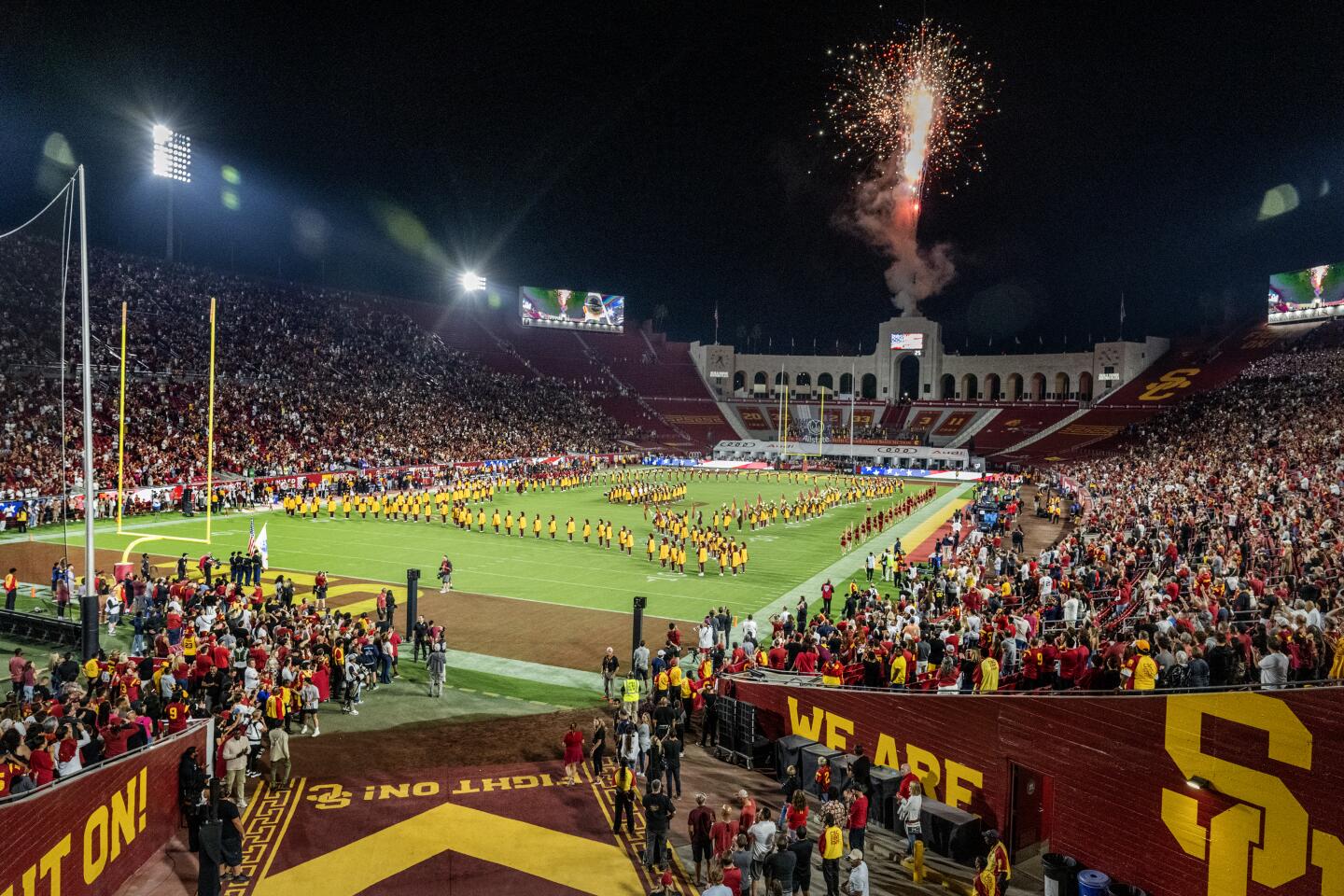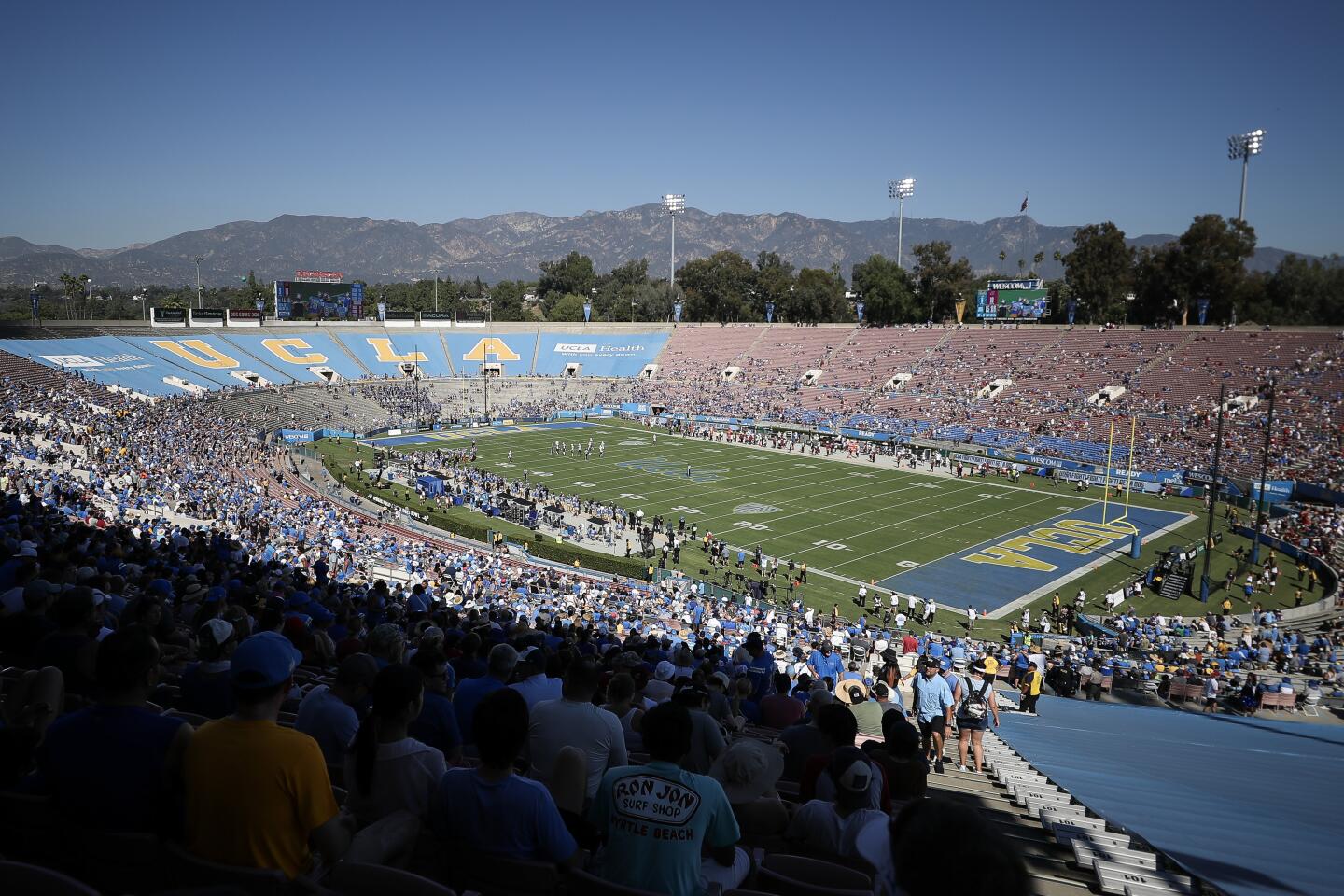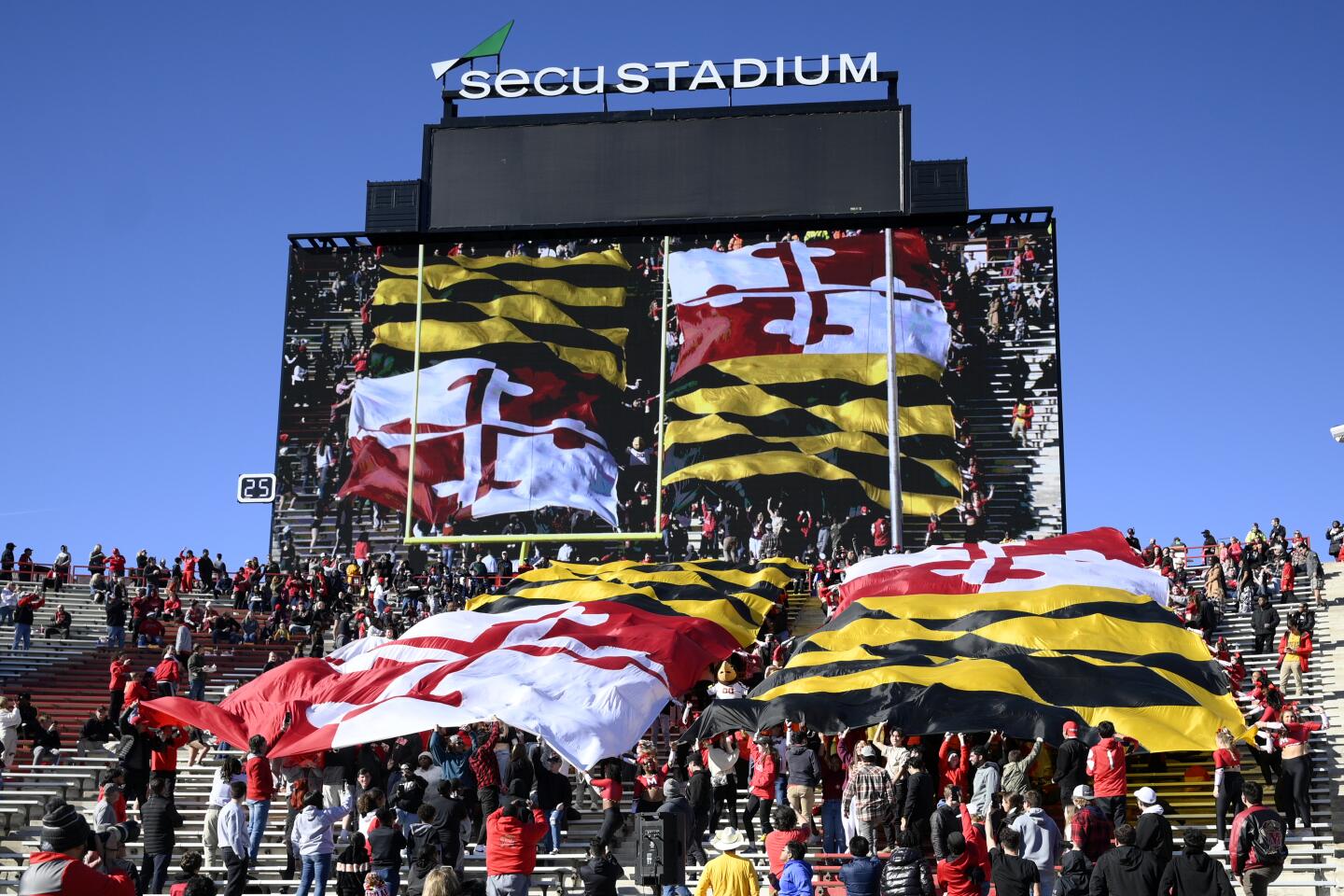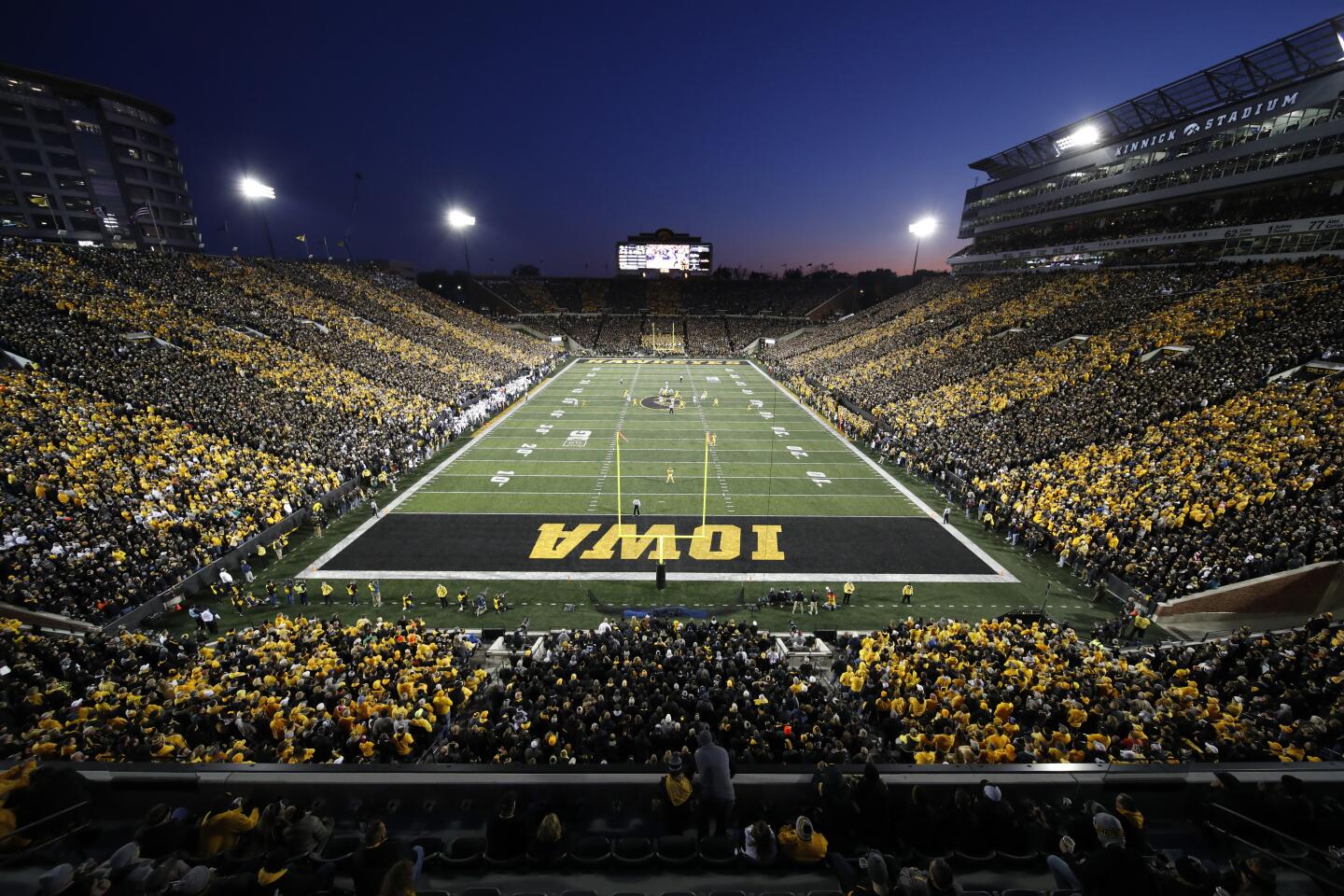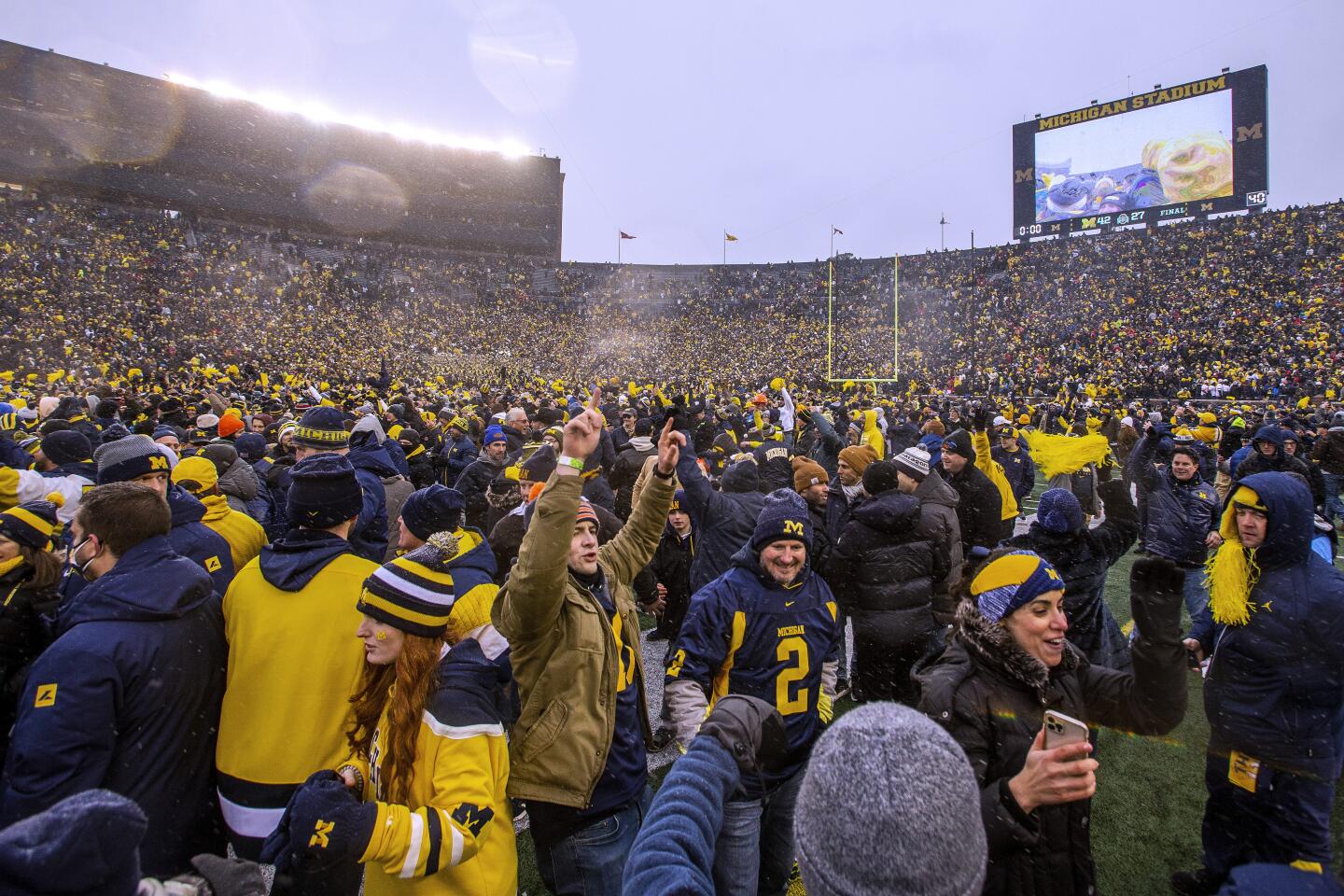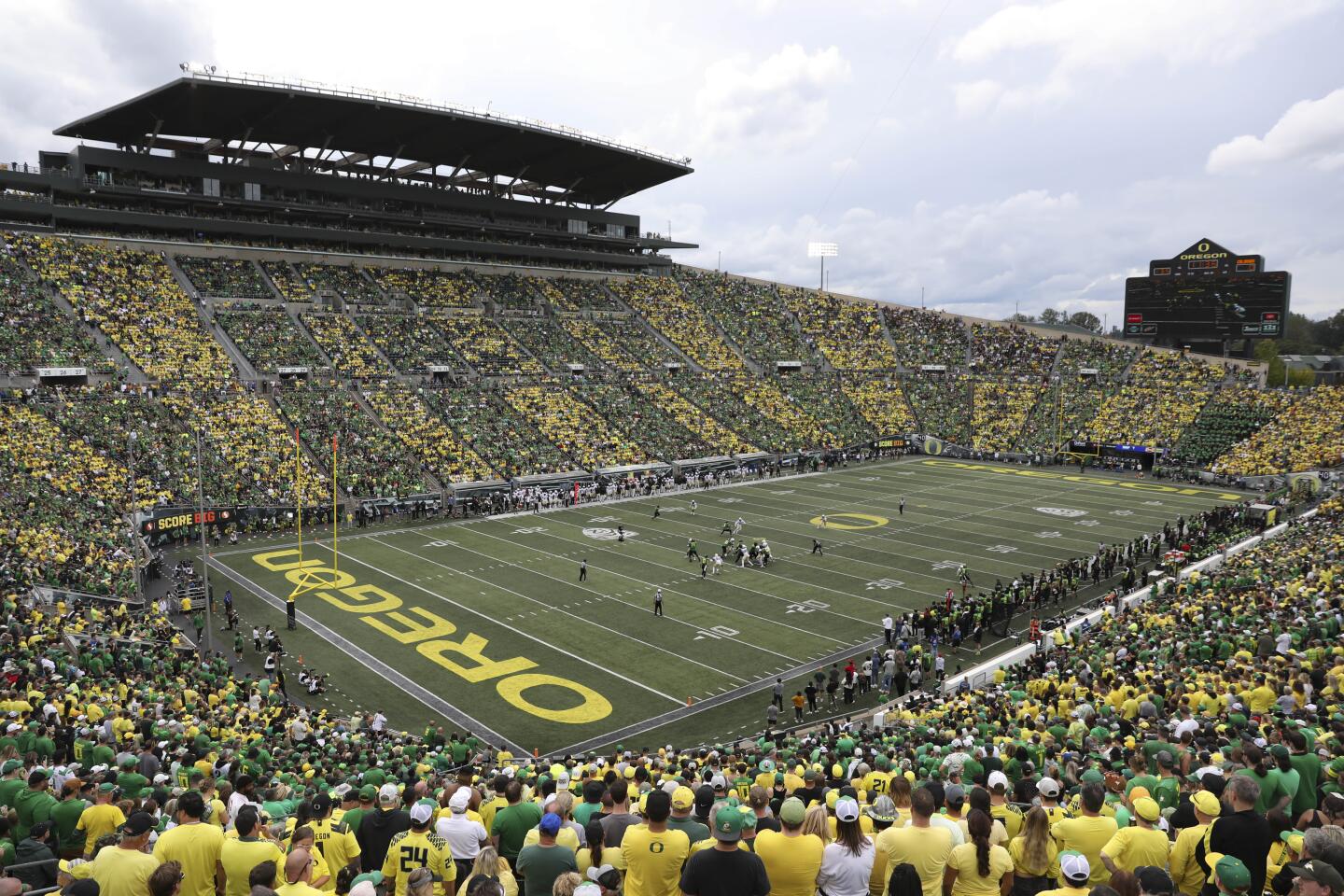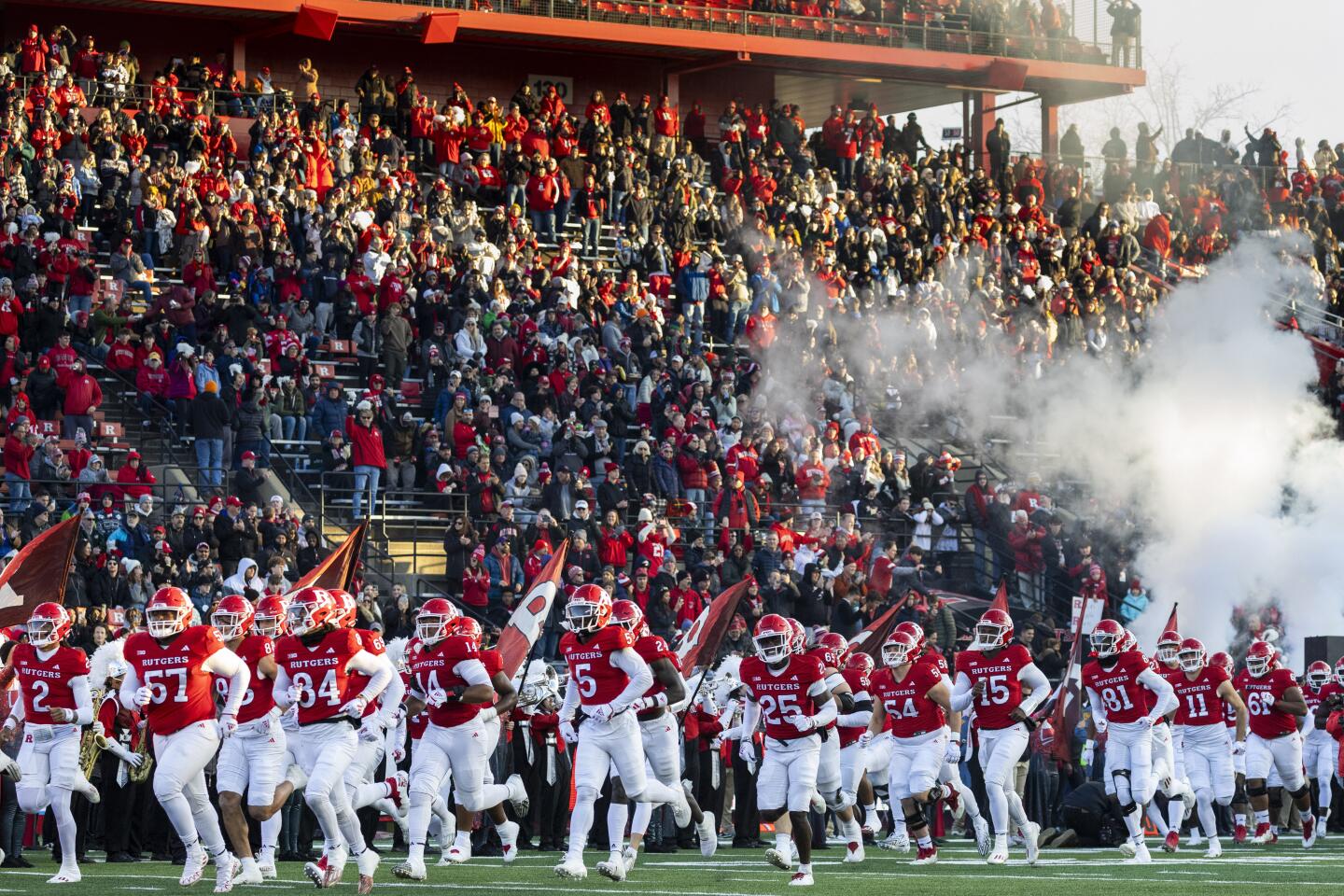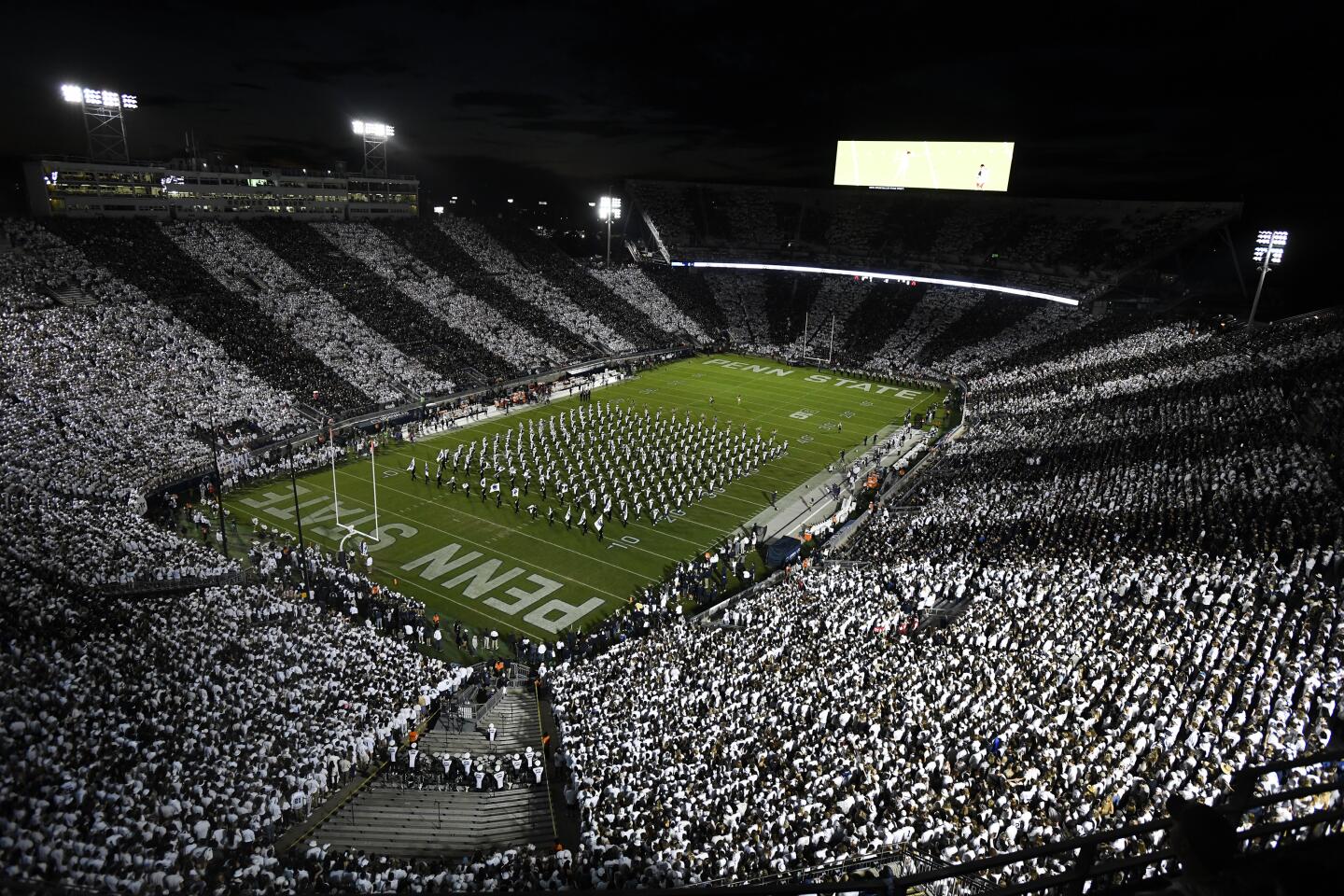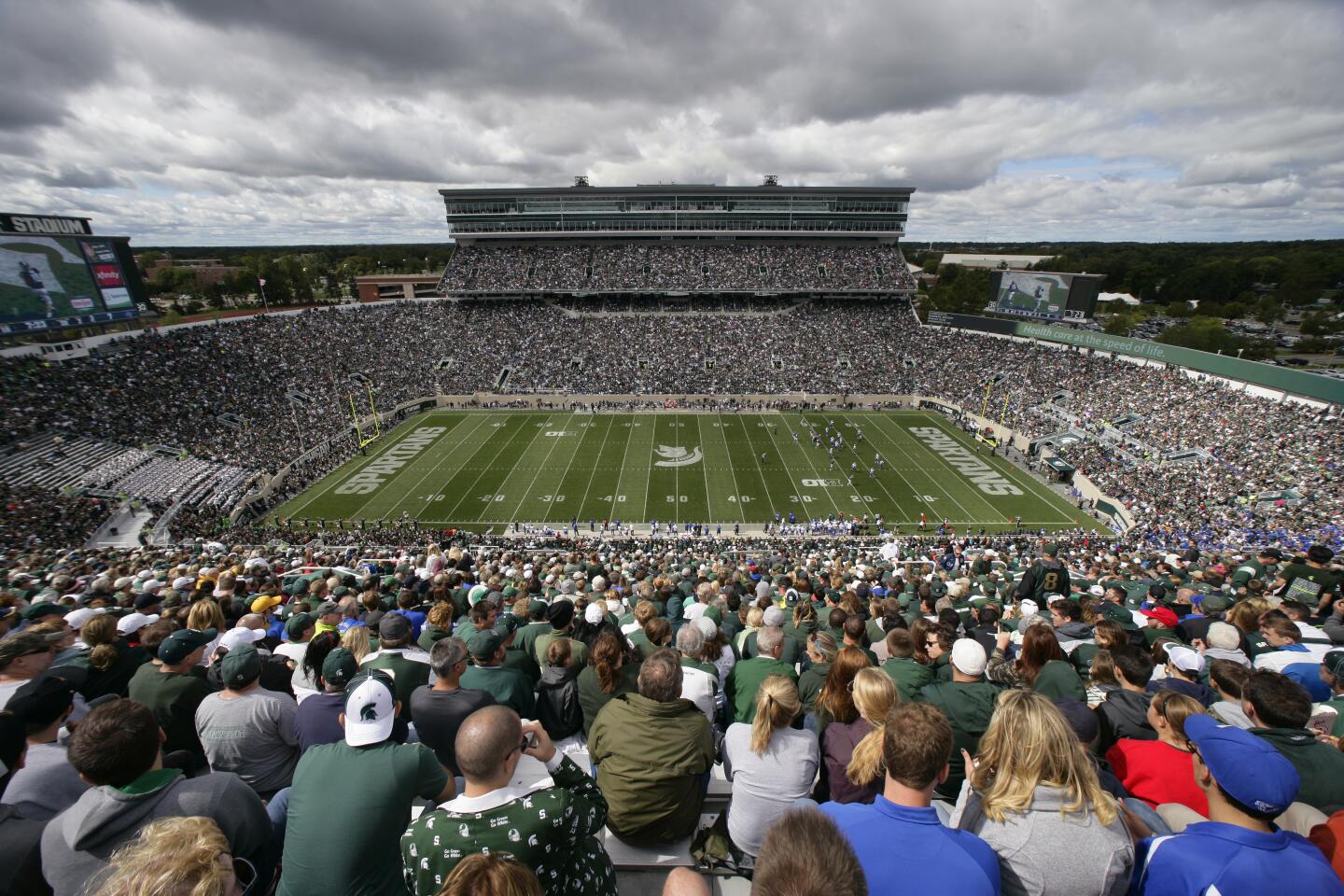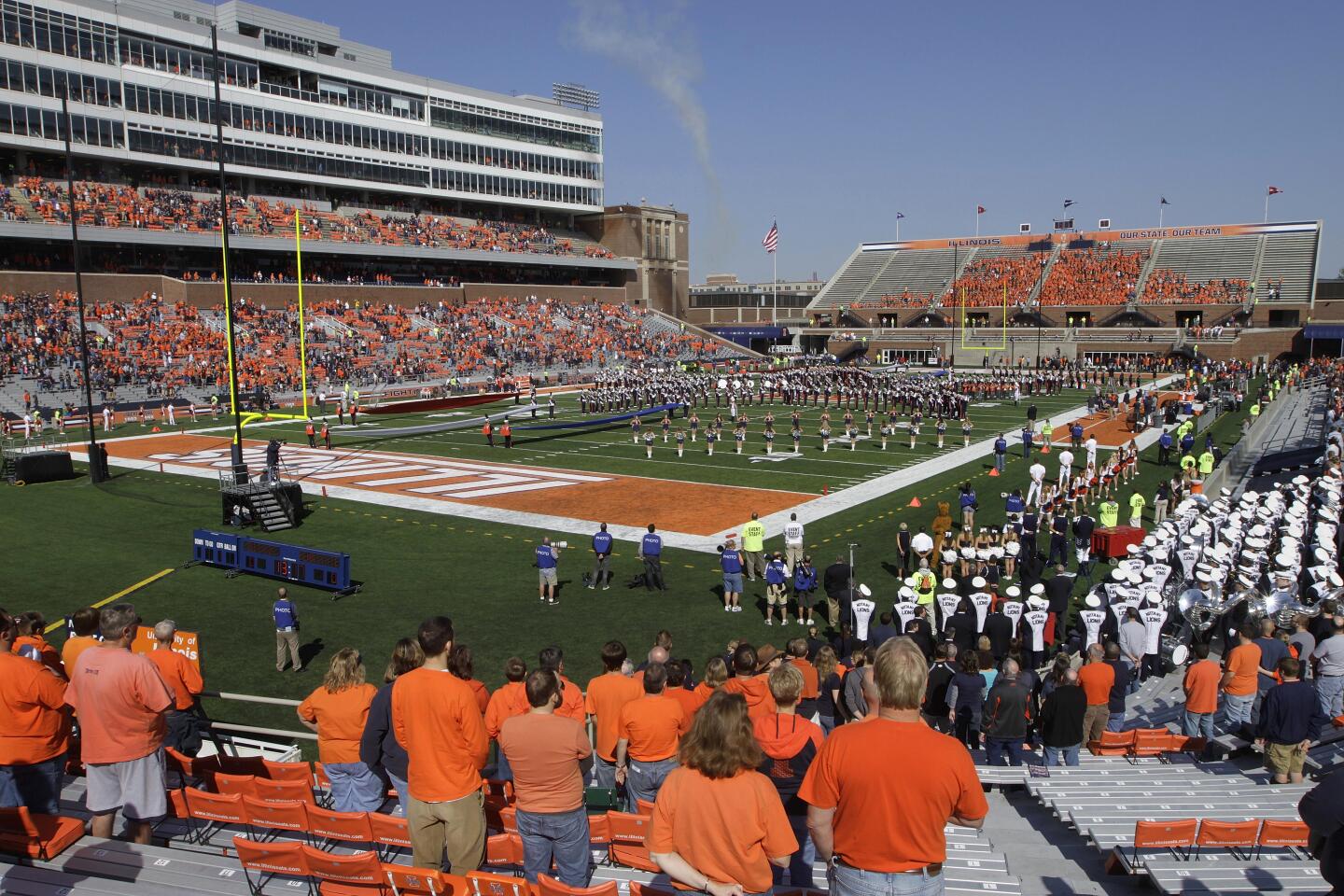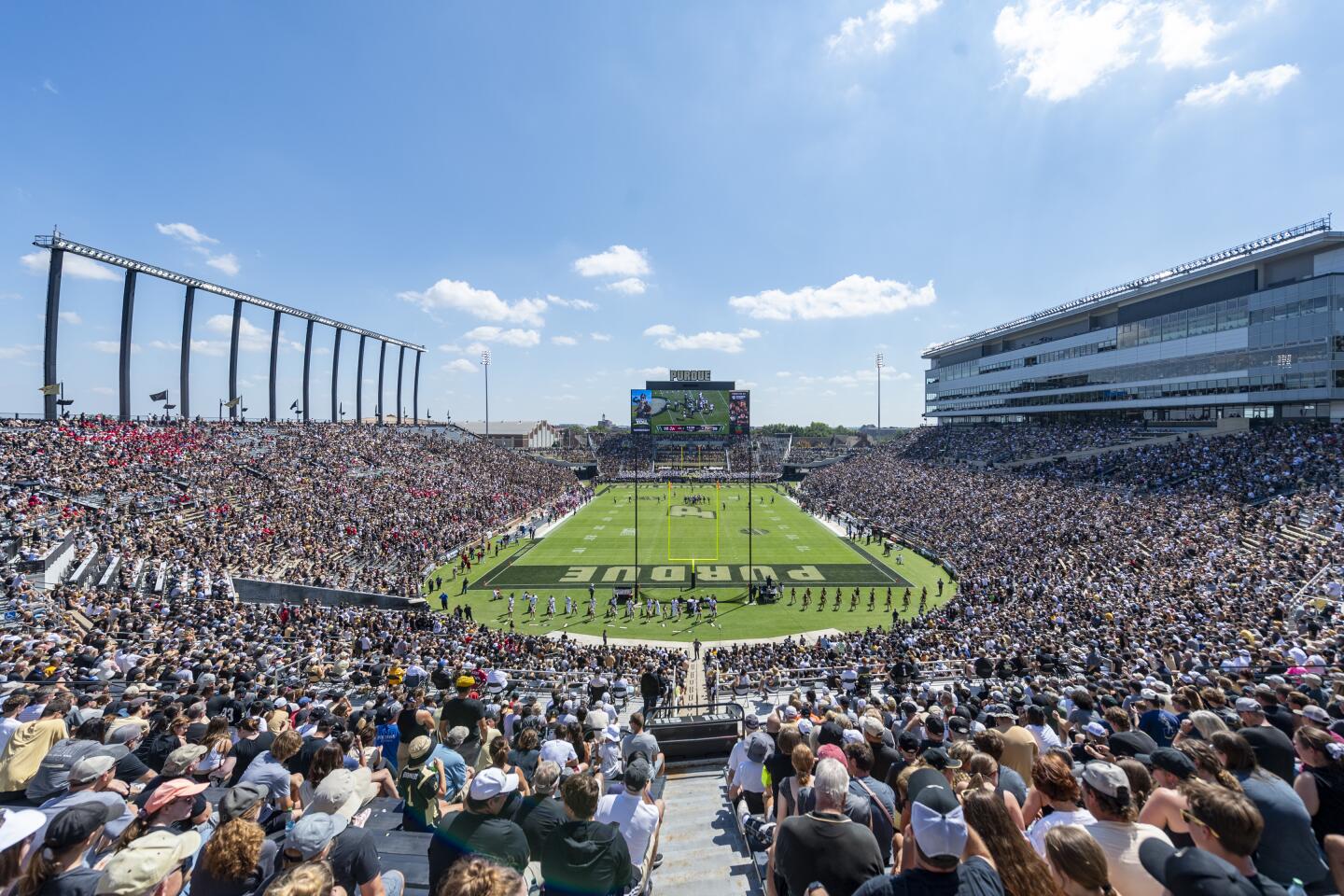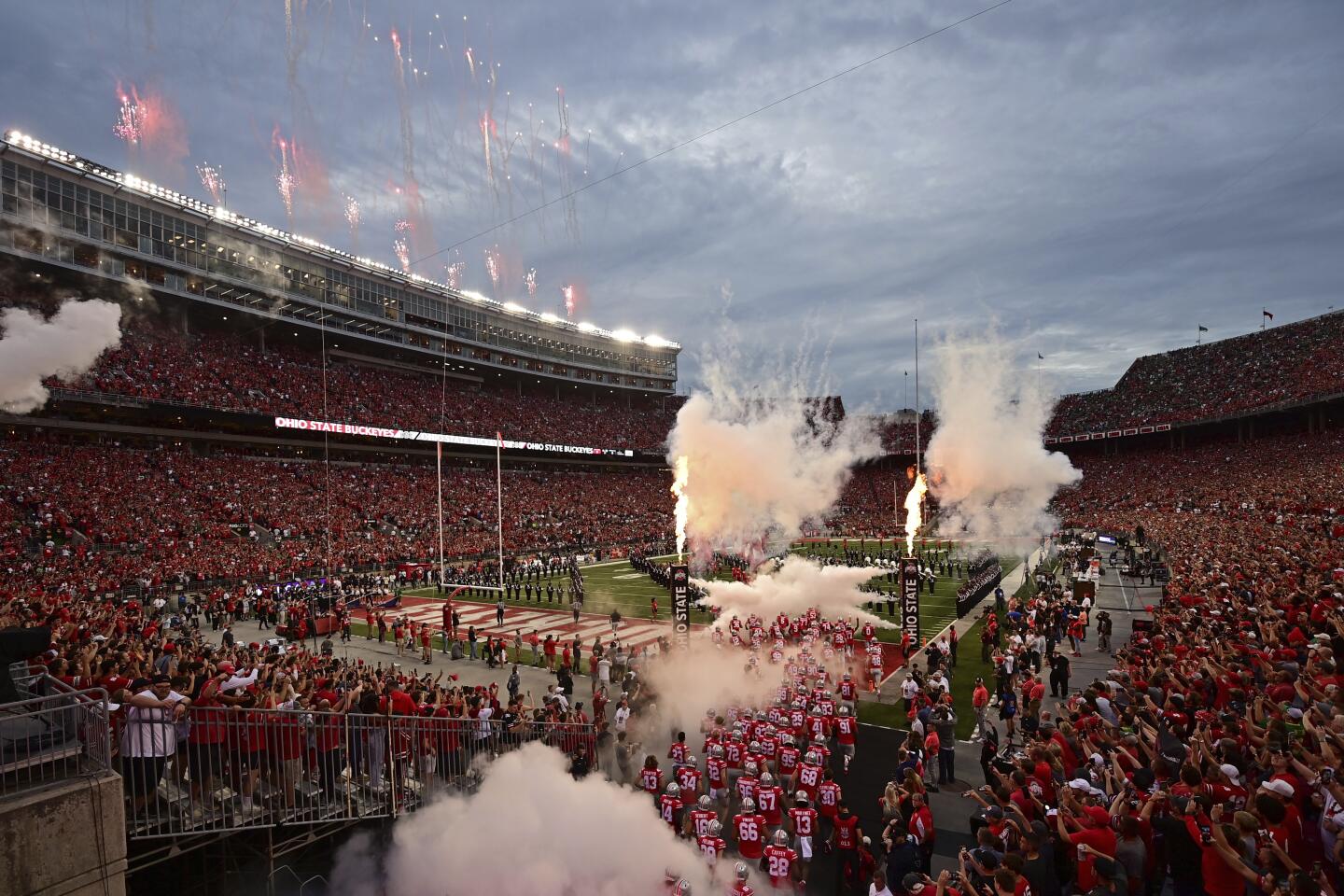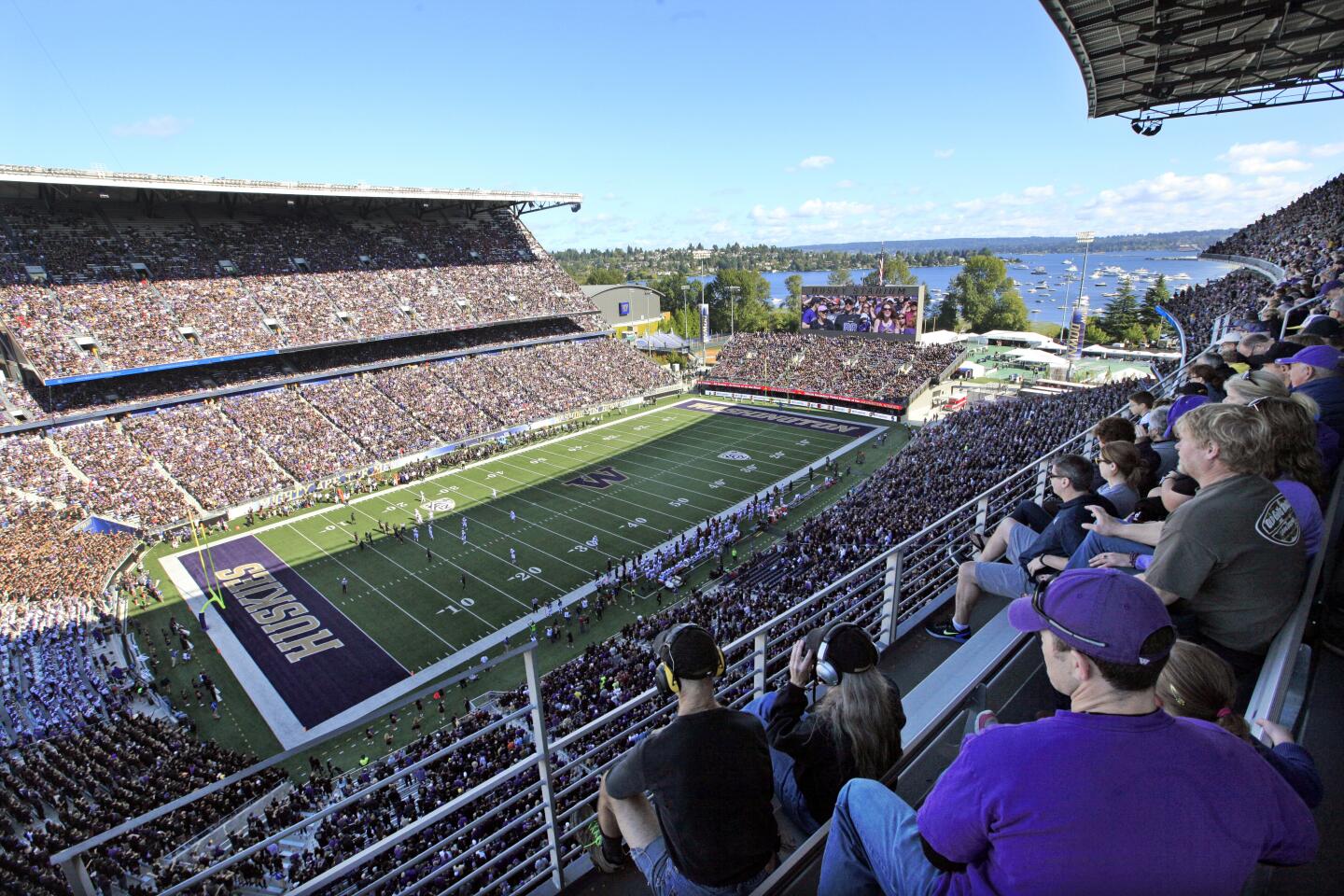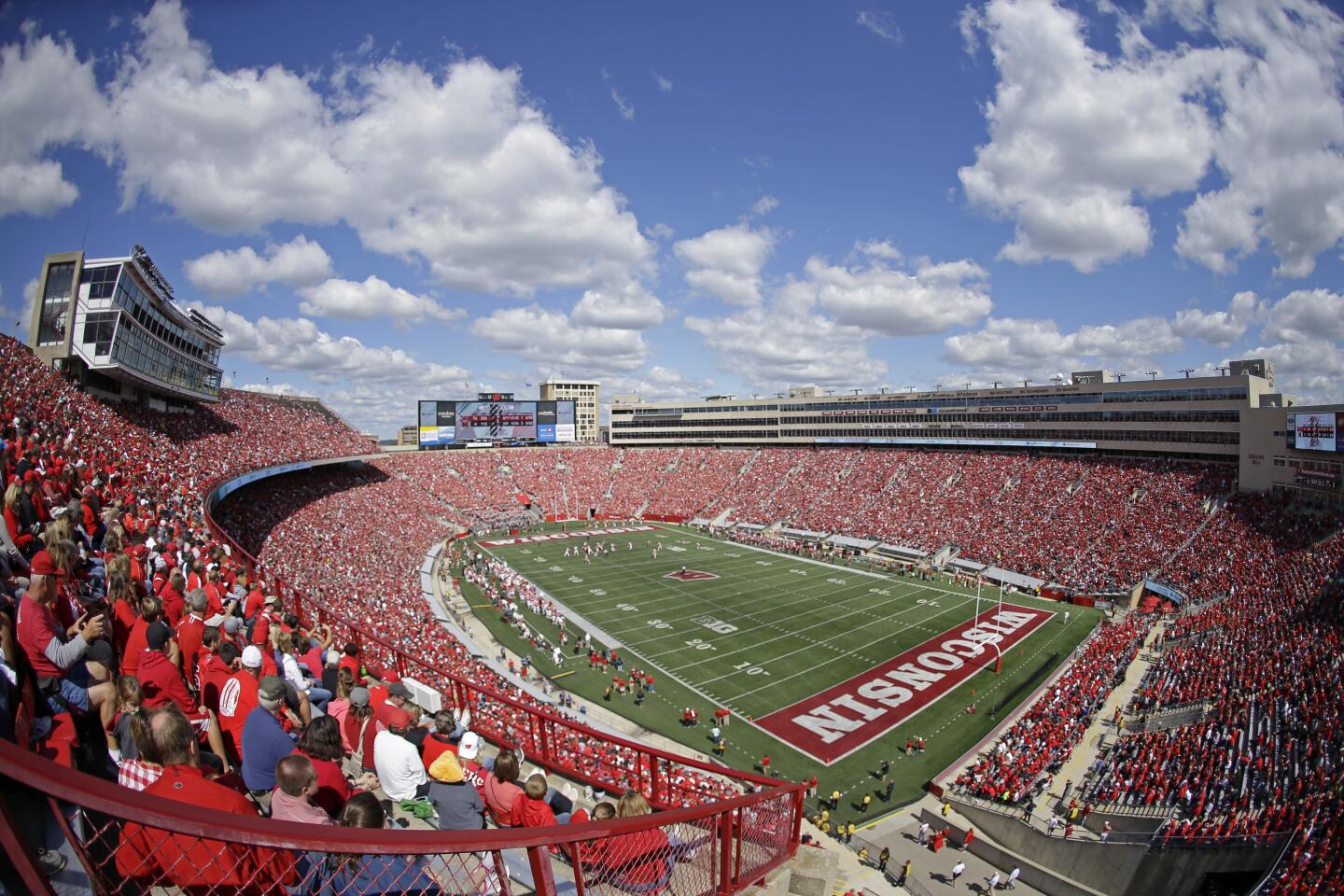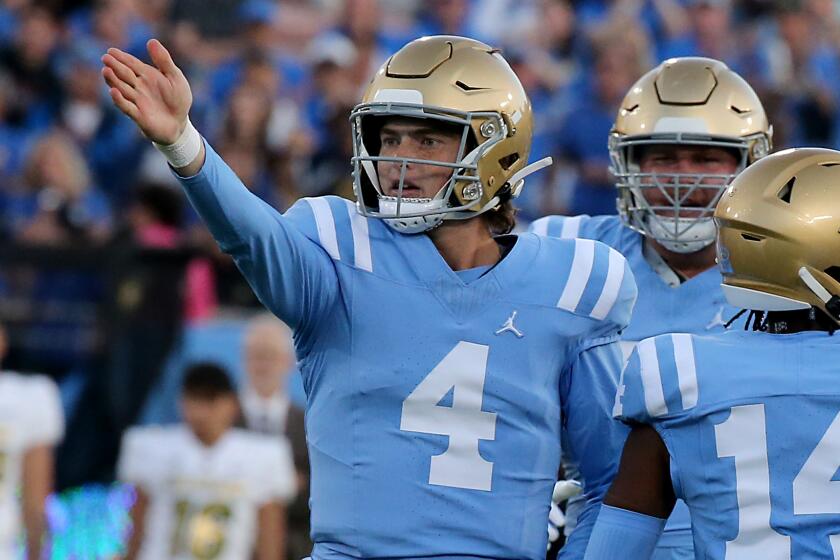Want to attend a Big Ten football game? Here’s a guide to all 18 stadiums
- Share via
Hey there, fans of USC, UCLA, Oregon and Washington football.
Welcome to the Big Ten Conference.
Sure, conference road games may be a bit farther away (much more than 2,000 miles in many cases) than they were in the Pac-12 days.
But just think of all the fun, exciting and often historic venues — each with its own quirks and unique traditions — you’ll have the opportunity to visit.

Can Lincoln Riley cool down his already hot coaching seat? Can UCLA’s DeShaun Foster coach the team to a winning record?
Maybe you’ll attend a game at a venue with a nickname like the Big House, the Woodshed or the Shoe.
Perhaps you’ll have the chance to rub Testudo’s nose or Hep’s Rock.
Or marvel at Zeke the Wonder Dog or the world’s largest drum.
Or search for Crisler’s Seat, witness the Swarm, camp out in Nittanyville or behold the Dramatic Gopher (which is actually a chipmunk).
UCLA will be the only Big Ten team to have its students sitting directly behind their opponent, school officials said.
Or maybe you have no idea what any of that means, in which case this handy guide to all 18 stadiums in the new-look Big Ten should come in quite handy.
And for everyone coming to a game on the West Coast for the first time, this guide is for you too. Just make sure to learn the “Eight-clap” and be prepared to “Fight on!”
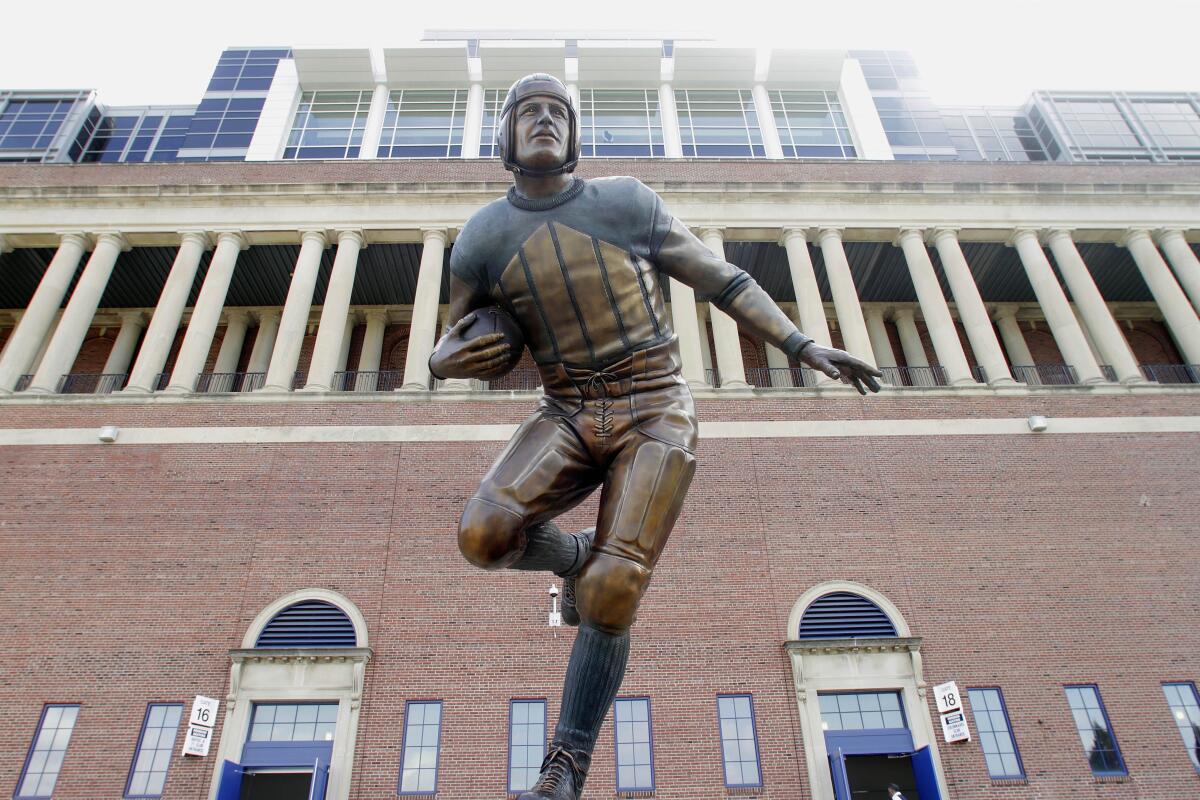
Illinois Fighting Illini (Memorial Stadium)
Year opened: 1923
Distance from L.A.: 2,005 miles
When will UCLA play there? 2027
When will USC play there? 2025
Nearby attractions: Krannert Art Museum, tThe Virginia Theatre
Illini halfback Red Grange finished with 402 total yards and six touchdowns Oct. 18, 1924, the day the stadium was dedicated. The facility’s website says it “remains the single greatest performance in Memorial Stadium history.”
Grange is honored with a statue outside the stadium and Grange Rock, which sits at the north end of the football field and came from the same quarry as the stadium’s columns. Those columns are engraved with the names of 189 Illinois students and alumni who died during World War I.
The student section is called “Block I,” and its occupants enjoy dancing and cheering along with the Marching Illini to such tunes as the funky “Low Brass” (which involves fans gyrating and shouting “Yeah! Oh Yeah!”) and the “William Tell Overture” (which requires fans to jump up and down with their arms around each other).
The bell from the never-completed USS Illinois battleship resides at the stadium and is rung after every Fighting Illini touchdown.
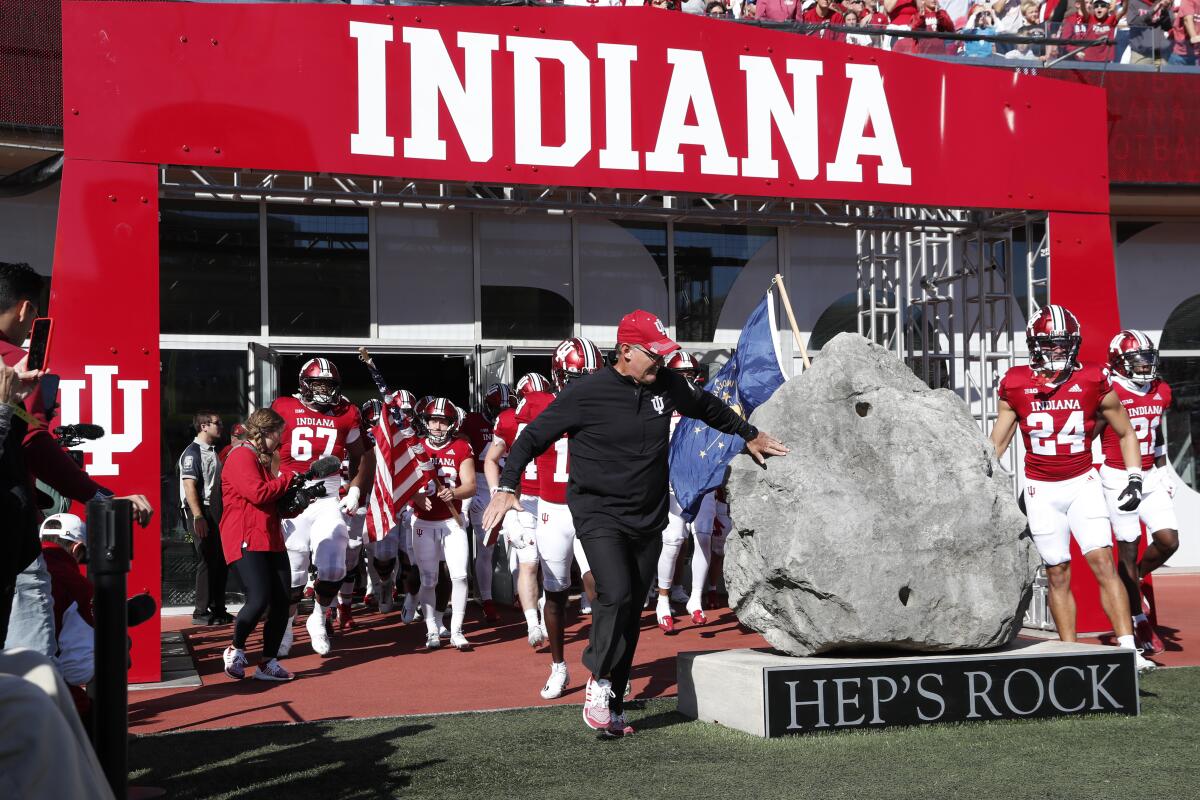
Indiana Hoosiers (Memorial Stadium)
Year opened: 1960
Distance from L.A.: 2,052 miles
When will UCLA play there? 2025
When will USC play there? 2026
Nearby attractions: Kirkwood Avenue, The Square, Monroe Lake
The stadium informally known as “The Rock” now has a three-ton piece of limestone on its east concourse. And it’s not just any three-ton piece of limestone.
Hep’s Rock was part of the original Memorial Stadium (1925-1959). In a tradition started by late former Indiana coach Terry Hoeppner, players and coaches touch the rock for good luck before home games. Located in the north end zone from 2005-2023, the beloved fixture was moved this offseason to be more accessible to fans while still receiving its obligatory pregame touches from the team.
Hoosiers fans show their support with the school’s signature “Fists and Blades” cheer. After Indiana scores, members of the university’s Army ROTC Bison Battalion fire off a salute from Big Jake, a 75mm pack howitzer located behind the north end zone. Parts of the USS Indiana battleship are displayed outside the stadium in honor of those who served on the ship from 1942-1947.
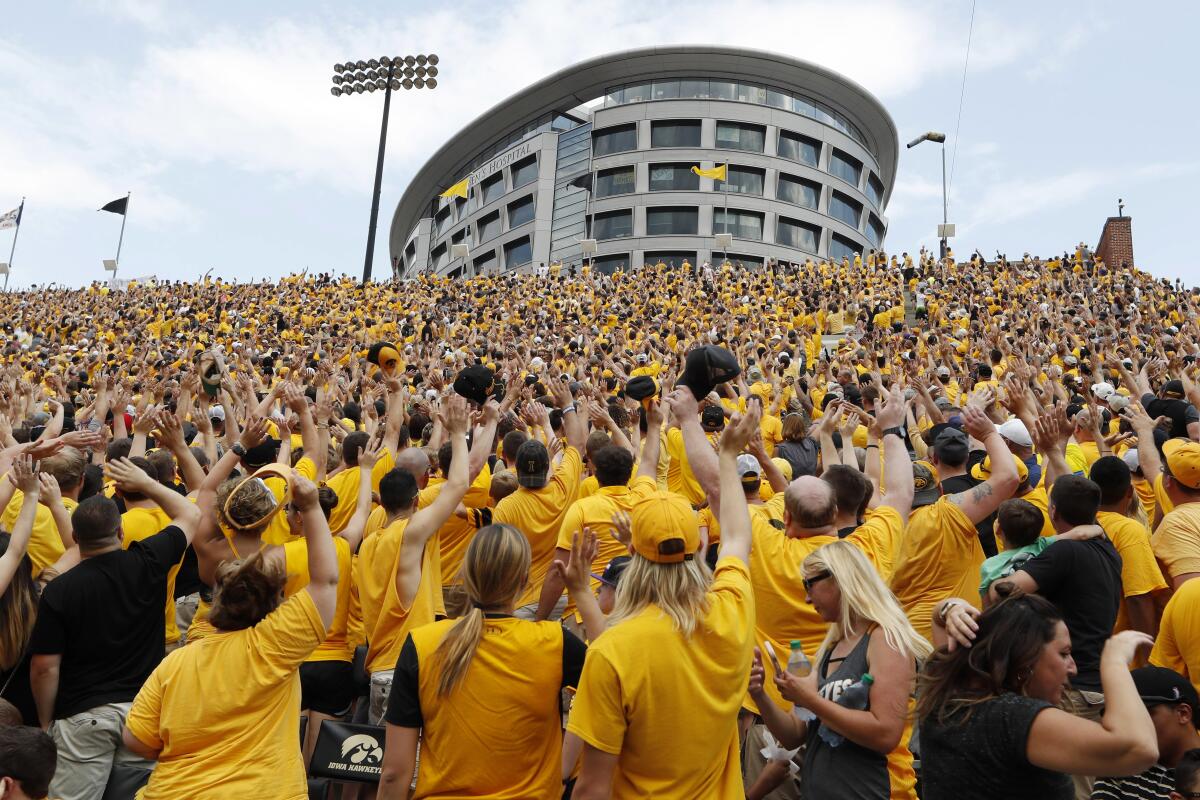
Iowa Hawkeyes (Kinnick Stadium)
Year opened: 1929
Distance from L.A.: 1,797 miles
When will UCLA play there? 2027
When will USC play there? 2027
Nearby attractions: The Englert Theatre, Devonian Fossil Gorge
The stadium is named after Nile Kinnick, the only Iowa player to win the Heisman Trophy, in 1939. A video of Kinnick giving his acceptance speech for the award is played on the scoreboard before every home game.
With “Back in Black” by AC/DC and “Enter Sandman” by Metallica playing in the background, the Hawkyes emerge slowly from the tunnel, join hands and jog (not run) onto the field — a tradition known as “The Swarm.”
Another game-day ritual is “the Hawkeye Wave.” which takes place at the end of the first quarter. At that time, everyone in attendance waves to those watching from the Stead Family Children’s Hospital, which overlooks the stadium and provides a stellar view of all Iowa home games for the patients and their families.
Following Iowa wins, university faithful sing along as the band plays the “Hawkeye Victory Polka,” which includes the lyrics, “In Heaven there’s no beer, that’s why we drink it here.”
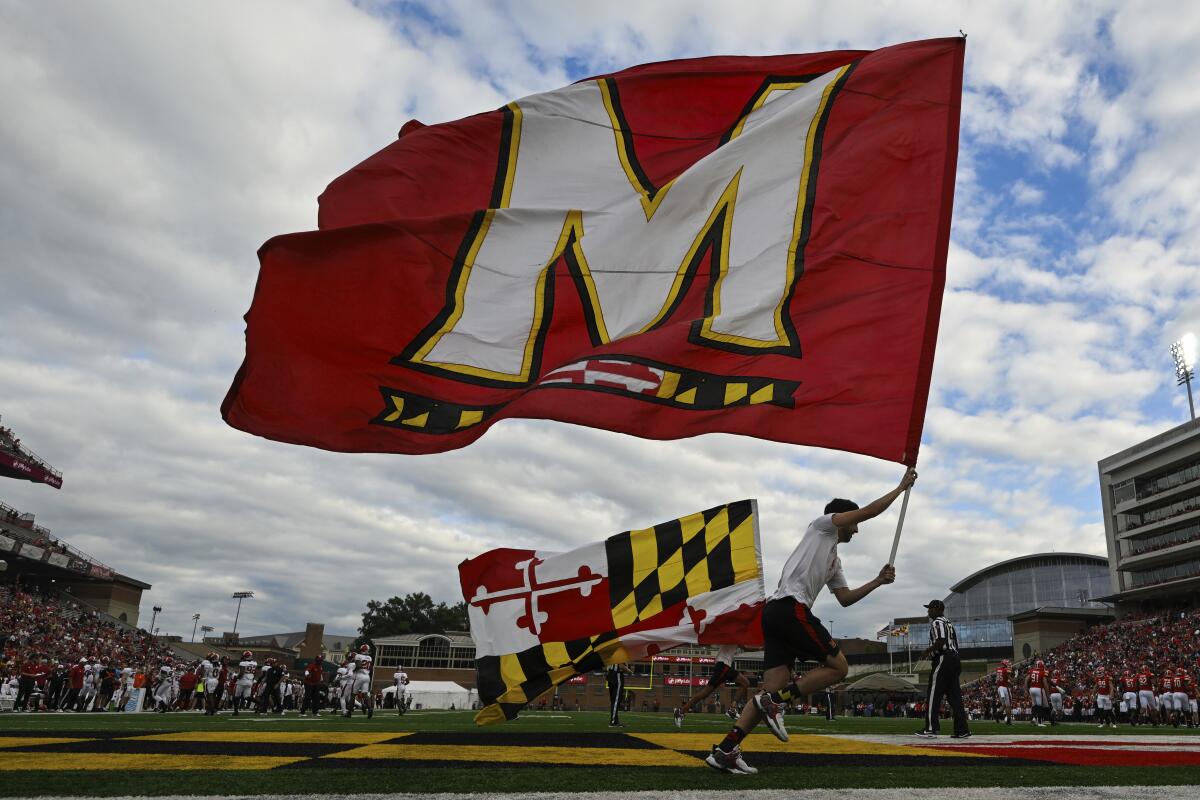
Maryland Terrapins (SECU Stadium)
Year opened: 1950
Distance from L.A.: 2,640 miles
When will UCLA play there? 2026
When will USC play there? Oct. 19
Nearby attractions: Jim Henson Statue and Memorial Garden, Lake Artemesia
Testudo is a turtle who describes himself in his Instagram bio as a “nose rub lover,” which is a good thing because the Terrapins mascot gets lots of them. Maryland players touch the nostril area of a 300-pound Testudo statue inside SECU Stadium for good luck before home games. It’s one of several such statues around campus that receive the same treatment from students hoping for some prosperity.
Testudo also takes the form of a more traditional school mascot, who is tall and furry, entertains the crowd and also joins fans, the spirit squad and the Mighty Sound of Maryland marching band in cheering the players during their traditional “Terp Walk” to the stadium before games.
Another game-day ritual involves fans in the student section unfurling a gigantic replica of the Maryland state flag, while the theme to “2001: A Space Odyssey” plays over the sound system.
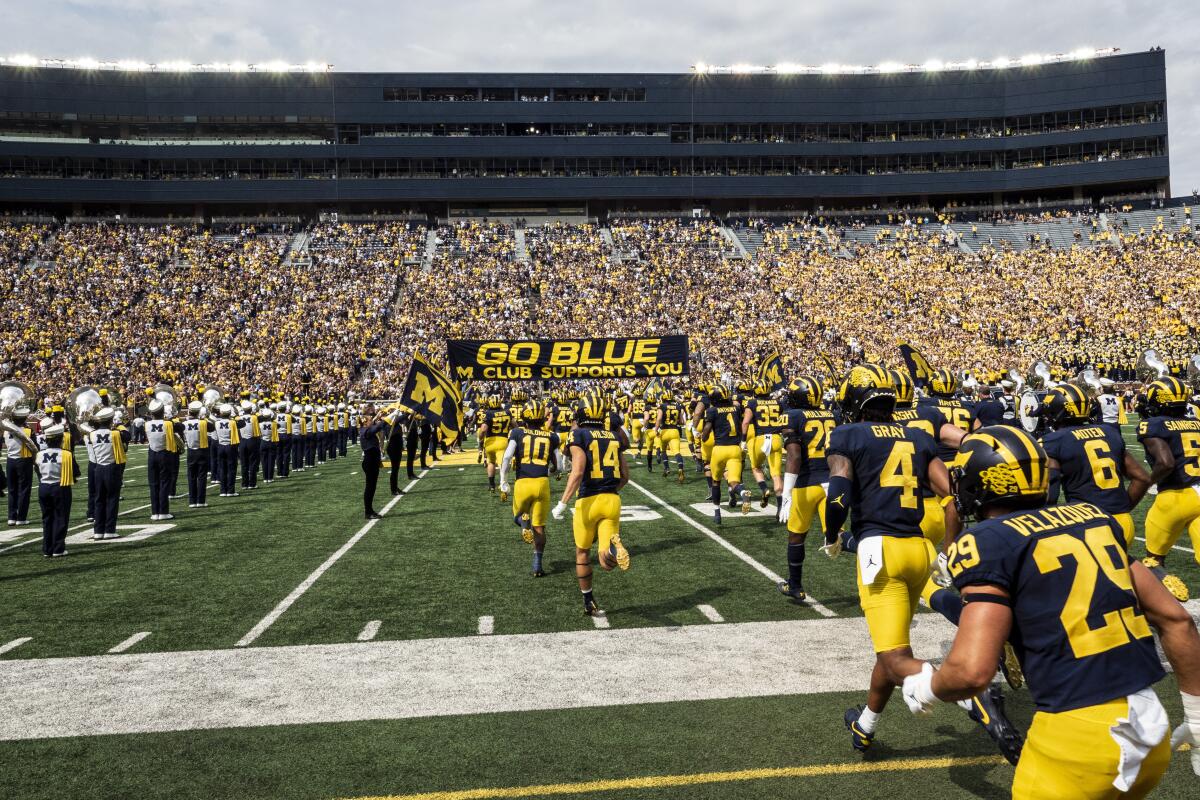
Michigan Wolverines (Michigan Stadium)
Year opened: 1927
Distance from L.A.: 2,240 miles
When will UCLA play there? 2026
When will USC play there? Sept. 21
Nearby attractions: Main Street, Hudson Mills Metropark
They don’t call it “the Big House” for nothing. The home of the Wolverines is the third largest stadium in the world and the largest in the Western Hemisphere. All that said, however, the stadium’s capacity number actually might be inflated — by one digit.
The “01” that has appeared at the end of all of the stadium’s capacity counts since 1956 represents “Crisler’s seat,” named for late Wolverines coach Fritz Crisler. Depending on which story you believe, either the seat resides within the stadium in a location only Crisler knew or it never actually existed at all.
On game days, the Wolverines run from the tunnel and leap to touch the “GO BLUE, M CLUB SUPPORTS YOU” banner, which is held high at midfield, for luck. Other traditions for Michigan fans include yelling “Go Blue!” after a cowbell plays and chanting “You suck!” when an opponent faces fourth down.
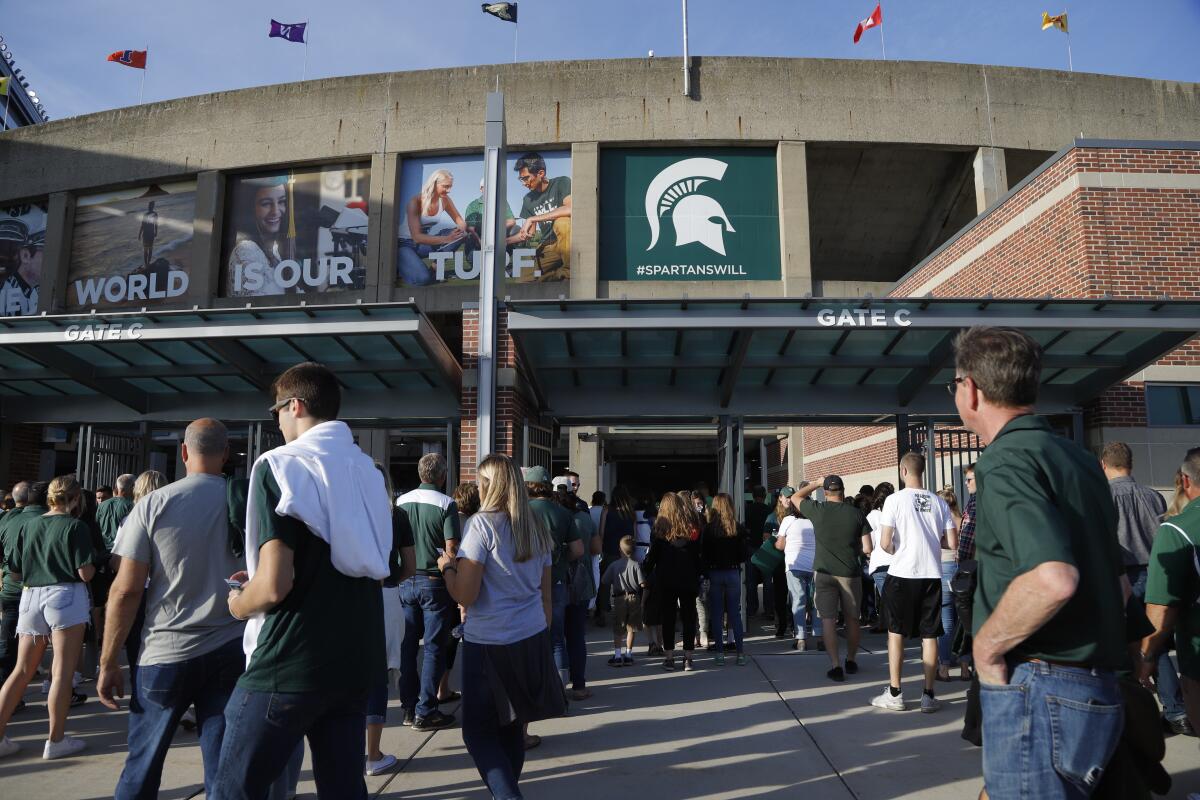
Michigan State Spartans (Spartan Stadium)
Year opened: 1923
Distance from L.A.: 2,221 miles
When will UCLA play there? 2025
When will USC play there? 2028
Nearby attractions: MSU Horticulture Gardens, Eli and Edythe Broad Art Museum
It’s always “a beautiful day for football” at the stadium known as “the Woodshed,” no matter what the actual weather conditions might be in East Lansing. It’s also always a great time for catching a Frisbee in one’s mouth, if that someone is Zeke the Wonder Dog, who regularly performs for fans at home games.
The original wonder dog — the only one whose real name actually was Zeke — was a yellow Labrador Retriever who belonged to a Michigan State student. The pooch got the Woodshed gig in 1977 after placing second in disc-catching world championship competition at the Rose Bowl stadium.
Michigan State fans also love the movie “300,” starring Gerard Butler as King Leonidas of the Ancient Greece city of Sparta. When opposing teams face third down, a clip from the movie is played, with Leonidas shouting, “Spartans! What is your profession?” The crowd enthusiastically responds by shouting “Hoo! Hoo! Hoo!” followed by a lot of screaming.

Minnesota Golden Gophers (Huntington Bank Stadium)
Year opened: 2009
Distance from L.A.: 1,926 miles
When will UCLA play there? 2026
When will USC play there? Oct. 5
Nearby attractions: Minneapolis Sculpture Garden, Paisley Park
Be afraid, opposing kickers, be very afraid of (pause for effect) ... the Dramatic Gopher. As the visiting team attempts a field goal in the west end of the stadium, the giant video screen just above the goal posts shows an extreme closeup of an intense-looking furry creature in the hopes of distracting the kicker. (Here’s a little secret: the Dramatic Gopher is actually a chipmunk).
If you’re at the Bank to cheer on USC or UCLA, don’t be alarmed if Minnesota fans suddenly start chanting, “We hate Iowa!” Chances are, they’re aware that the Hawkeyes aren’t in town that week — those fans just really hate Iowa.
They also love to chant “Spin your head!” at Goldy Gopher, and the team mascot is always more than happy to oblige.
The walls of the tunnel leading out to the field are lined with oars that feature messages to the players, a nod to coach P.J. Fleck’s “Row the Boat” mantra.

Nebraska Cornhuskers (Memorial Stadium)
Year opened: 1923
Distance from L.A.: 1,497 miles
When will UCLA play there? Nov. 2
When will USC play there? 2026
Nearby attractions: Sunken Gardens, Museum of American Speed
The stadium is nicknamed “the Sea of Red,” and for good reason. Every Cornhuskers home game has been a sellout since 1962 — that’s a streak of 396 games, an NCAA record for any sport. All those fans make their presence known early, with a pregame chant that features one side of the stadium calling out “Husker!” and the other responding “Power!”
That’s followed by the team’s famous “Tunnel Walk,” during which the players and coaches take the field on a red carpet as the loudspeakers blare “Sirius” by Alan Parsons Project (yes, the song is most associated with the Michael Jordan-era Chicago Bulls, but it also has been part of the Cornhuskers game-day tradition for three decades).
There is one longtime ritual you won’t see during a visit to Lincoln. Nebraska stopped the practice of handing out red balloons for fans to release following the Cornhuskers’ first score in 2022, citing a helium shortage.
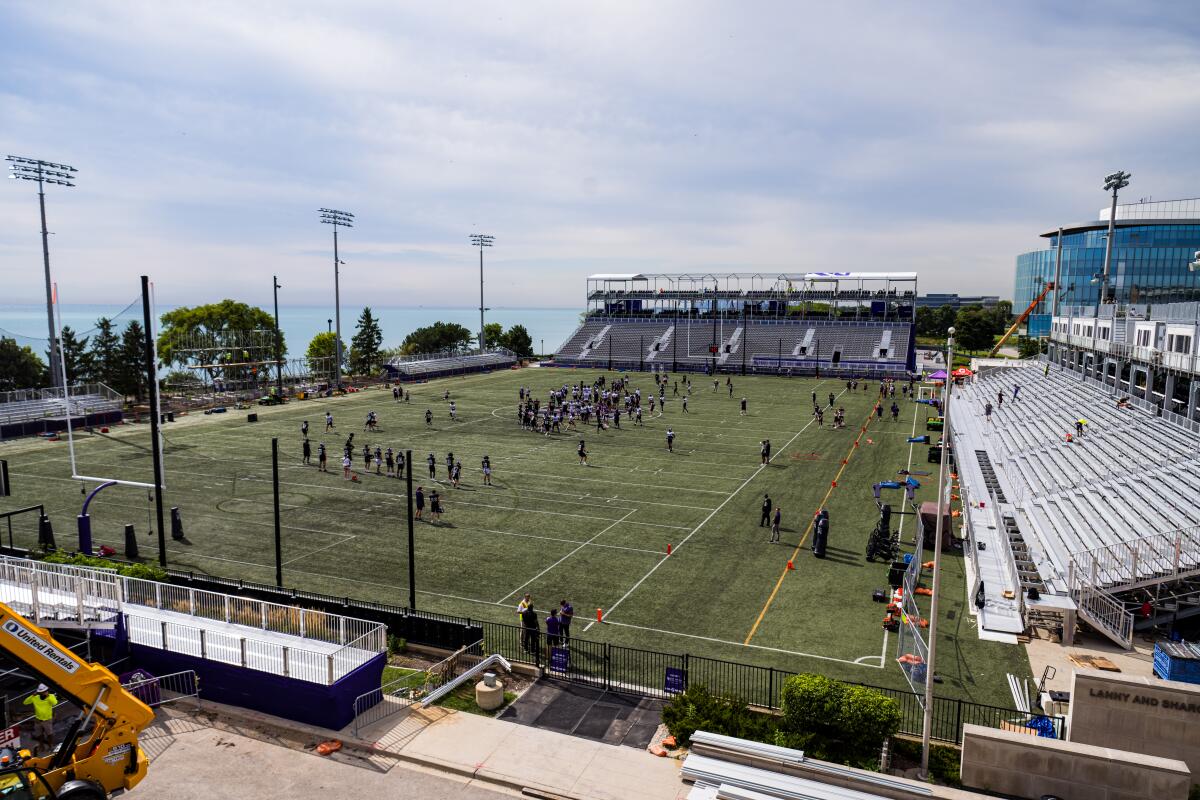
Northwestern Wildcats (Martin Stadium)
Year opened: 2024 (temporary facility)
Distance from L.A.: 2,023 miles
When will UCLA play there? 2025
When will USC play there? 2028 (at Ryan Field)
Nearby attractions: Evanston SPACE, Grosse Point Lighthouse
The Wildcats played at Ryan Field for 97 years before the stadium was demolished in April, and they will play at the new Ryan Field starting in 2026.
For the next two seasons, however, the Wildcats will play most of their home games in a temporary facility built at the school’s Lanny and Sharon Martin athletics complex, which also will continue to host games for Northwestern’s soccer and lacrosse teams. The football games will take place on an existing practice field, with the main grandstands constructed in a parking lot, all located on the shore of Lake Michigan.
The temporary venue might be tiny compared to the other home stadiums across the Big Ten, but it should be more than able to accommodate many of the fans’ game-day traditions, such as the “Keys at Kickoff” noisemaking ritual and the “Wildcat Growl and Claw” cheer.

Ohio State Buckeyes (Ohio Stadium)
Year opened: 1922
Distance from L.A.: 2,242 miles
When will UCLA play there? 2025
When will USC play there? 2027
Nearby attractions: North Market Downtown, German Village
These people love spelling the word “Ohio.” First, there’s the famous fan cheer. One quarter of the stadium starts by yelling “O!” followed by the other quadrants one at a time bellowing out their assigned letter. Obviously, the participants spell out the letters using their bodies as well.
Then there’s the iconic Script Ohio formation — the larger-than-life, ever-flowing, musical lesson in penmanship presented by the university’s marching band before every home game. The presentation is topped off, of course, by a sousaphone player breaking free and strutting out to “dot the i.” There have been a handful of “honorary i-dotters” over the years, including Bob Hope, Jack Nicklaus and John and Annie Glenn.
The stadium is also known as “the Shoe” for its double-decker, horseshoe design. Outside is Buckeye Grove, where a tree has been planted for every Ohio State player to be named first-team, All-America.
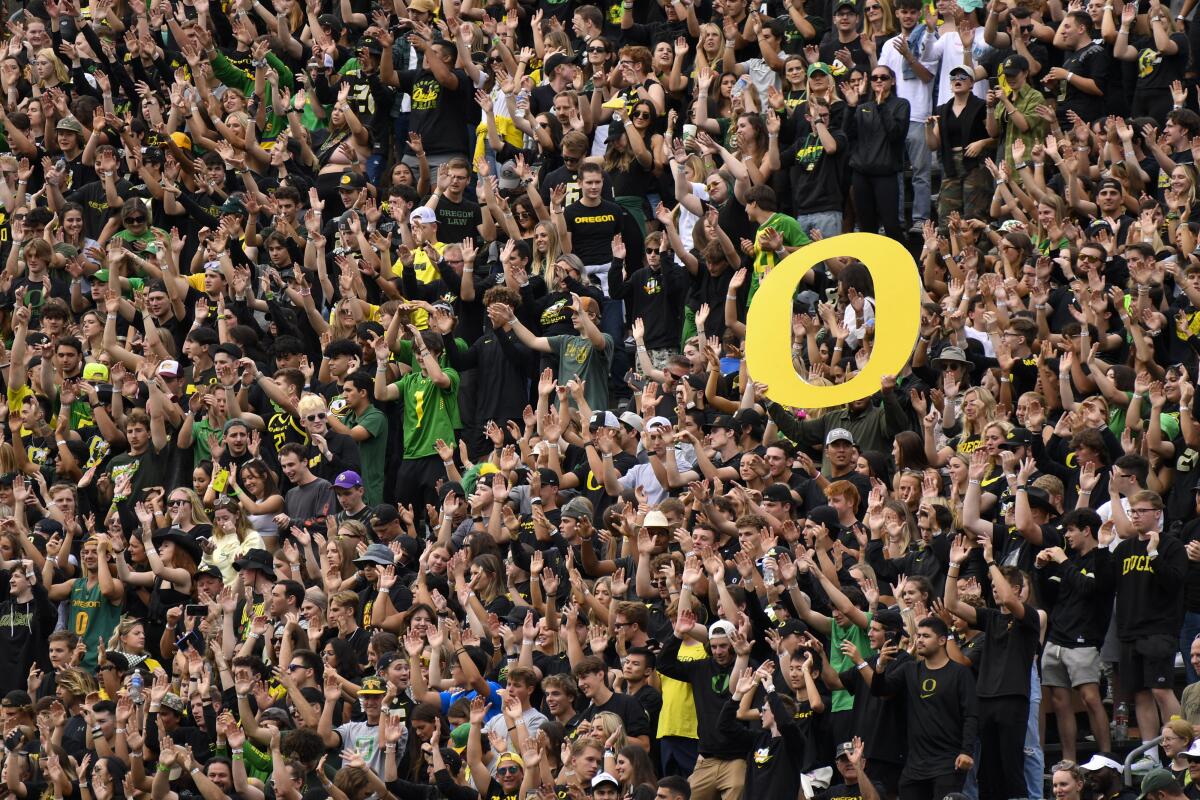
Oregon Ducks (Autzen Stadium)
Year opened: 1967
Distance from L.A.: 857 miles
When will UCLA play there? 2026
When will USC play there? 2025
Nearby attractions: Eugene Saturday Market, Cascades Raptor Center
This place is loud — not that football fans from the Southland should have to be reminded about the noise at the home of their former Pac-12 rivals. The volume at the venue also known as the Autzen Zoo reached a reported level of 127.2 decibels during USC’s 24-17 loss to the Ducks on Oct. 27, 2007.
Another fun fact about the facility (that isn’t actually a fact): “It never rains at Autzen Stadium.” That’s according to longtime stadium announcer Don Essig, who has made that announcement at home games since 1990, even when the actual weather conditions would indicate otherwise.
At the end of the third quarter, fans dance to the Isley Brothers’ “Shout” as a clip from “National Lampoon’s Animal House” (which was filmed at various sites on the Oregon campus, including Autzen Stadium) is shown on the video screen.
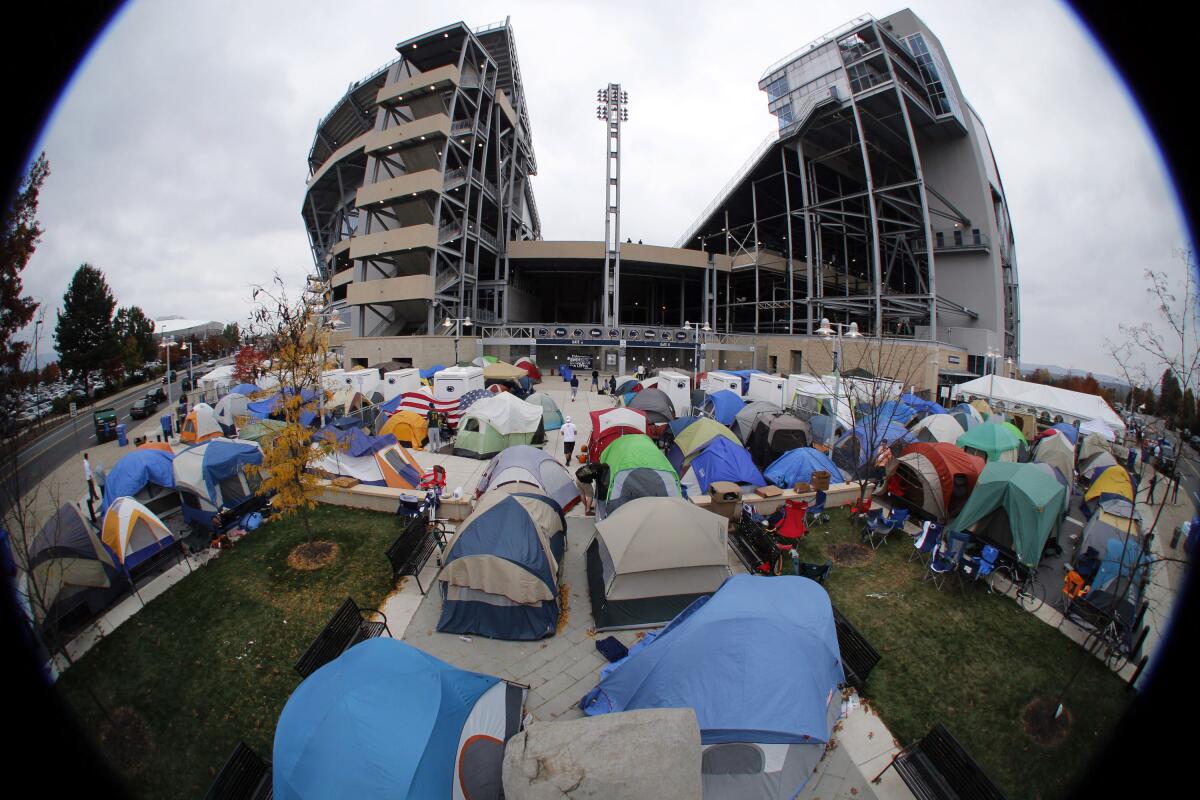
Penn State Nittany Lions (Beaver Stadium)
Year opened: 1960
Distance from L.A.: 2,569 miles
When will UCLA play there? Oct. 5
When will USC play there? 2026
Nearby attractions: Central PA Tasting Trail, Penn’s Cave & Wildlife Park
They are Penn State. Anyone attending a Nittany Lions home game will be reminded of that fact countless times — with “We are ... Penn State” being shouted call-and-response style across the stadium or with the phrase being yelled in unison during melody breaks in Zombie Nation’s “Kernkraft 400.”
While there are numerous other traditions at the country’s second largest stadium — including a flipping drum major and the yearly white-out game — one ritual actually starts several days before home games. Nittanyville is the name of the tent city outside the stadium’s Gate A where students camp out in order to get the best seats, and to take part in various festivities.
Beaver Stadium will continue to host games even as a major renovation is underway. While the project won’t be complete until 2027, fans already will be able to enjoy updated video scoreboards and new concession areas this season.
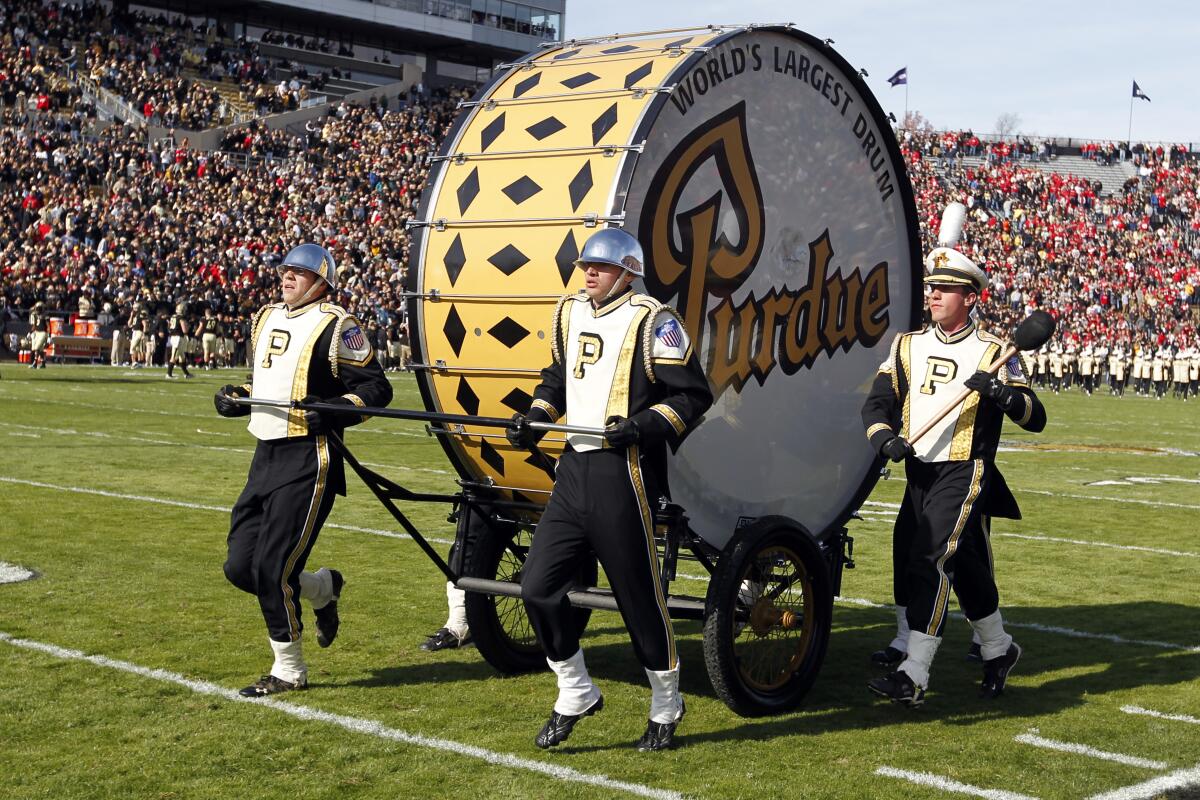
Purdue Boilermakers (Ross-Ade Stadium)
Year opened: 1924
Distance from L.A.: 2,094 miles
When will UCLA play there? 2027
When will USC play there? 2025
Nearby attractions: Celery Bog Nature Area, Exploration Acres
The stadium celebrated its 100th season last year. That’s a long time. Wanna know something that’s been around even longer? The “World’s Largest Drum.”
Created in 1921 for the Purdue All-American Marching Band, the bass drum is 8 feet in diameter, nearly 4 feet wide and weighs 315 pounds. It takes four band members to wheel it around on its 250-pound, steel-frame carriage, plus two more band members on either side to actually beat the drum (or use it in other creative ways).
Purdue also claims to have “the world’s largest, fastest, heaviest, and loudest collegiate mascot” — the Boilermaker Special VII, an actual train that makes appearances at every football game, home or away. A smaller version, the Boilermaker Xtra Special, leads the team onto the field before home games.
Also during your time at Ross-Ade, be prepared to hear folks shout “Boiler up!” A lot.
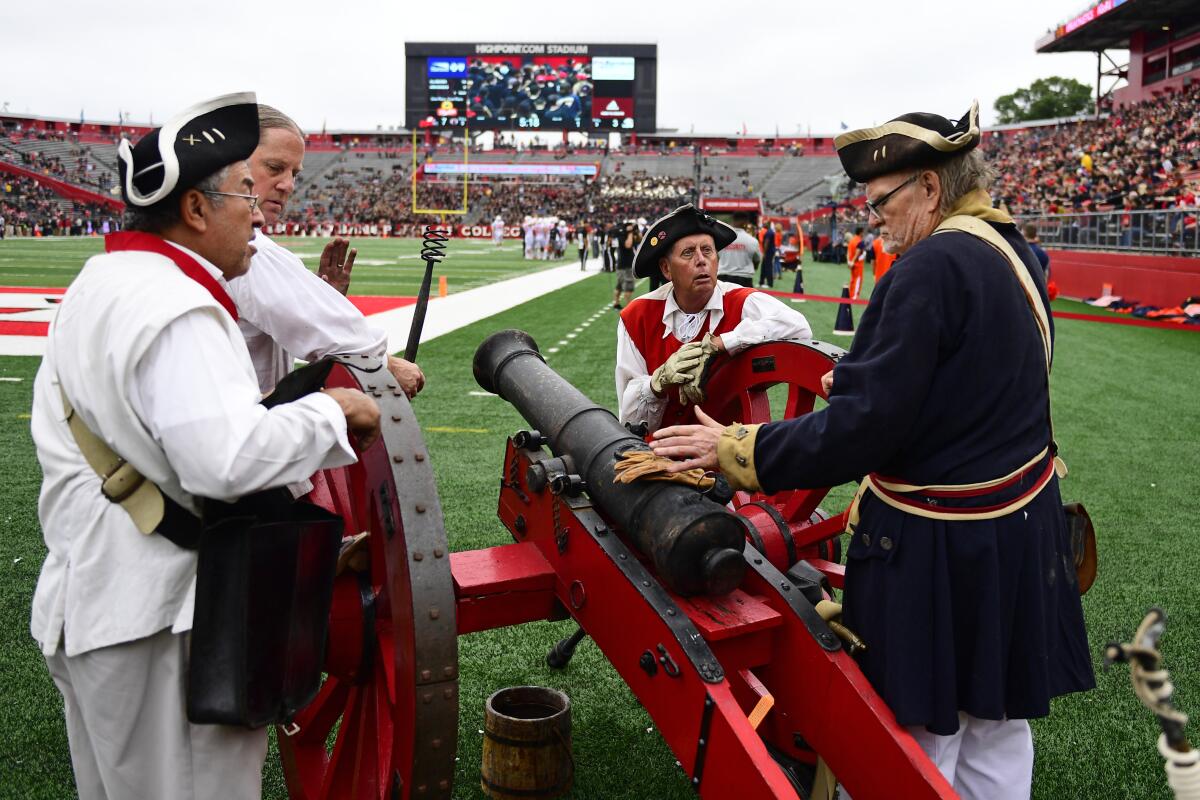
Rutgers Scarlet Knights (SHI Stadium)
Year opened: 1994
Distance from L.A.: 2,752 miles
When will UCLA play there? Oct. 19
When will USC play there? 2026
Nearby attractions: East Jersey Old Town Village, Passion Puddle
Rutgers is one of nine U.S. colleges chartered before the American Revolution, which helps explain why a bunch of Revolutionary War reenactors shoot off a cannon at various points during home games, including after every Scarlet Knights score.
That’s a cool tradition, except that Rutgers isn’t traditionally an offensive juggernaut. In 2019, for example, the team scored 18 touchdowns, successfully kicked 18 extra points and made 11 field goals — that adds up to only 47 celebratory cannon shots for the season. The Scarlet Knights scored with more frequency last season, providing the folks in the old-time uniforms 86 opportunities to fire away.
During your visit, you’re sure to hear the Rutgers chant, which features lots of “Rah-rahs,” with a few “Hoos,” “Woos” and even some actual words thrown in.
The Scarlet Knights have played football on the site since 1938, when the first Rutgers Stadium opened.
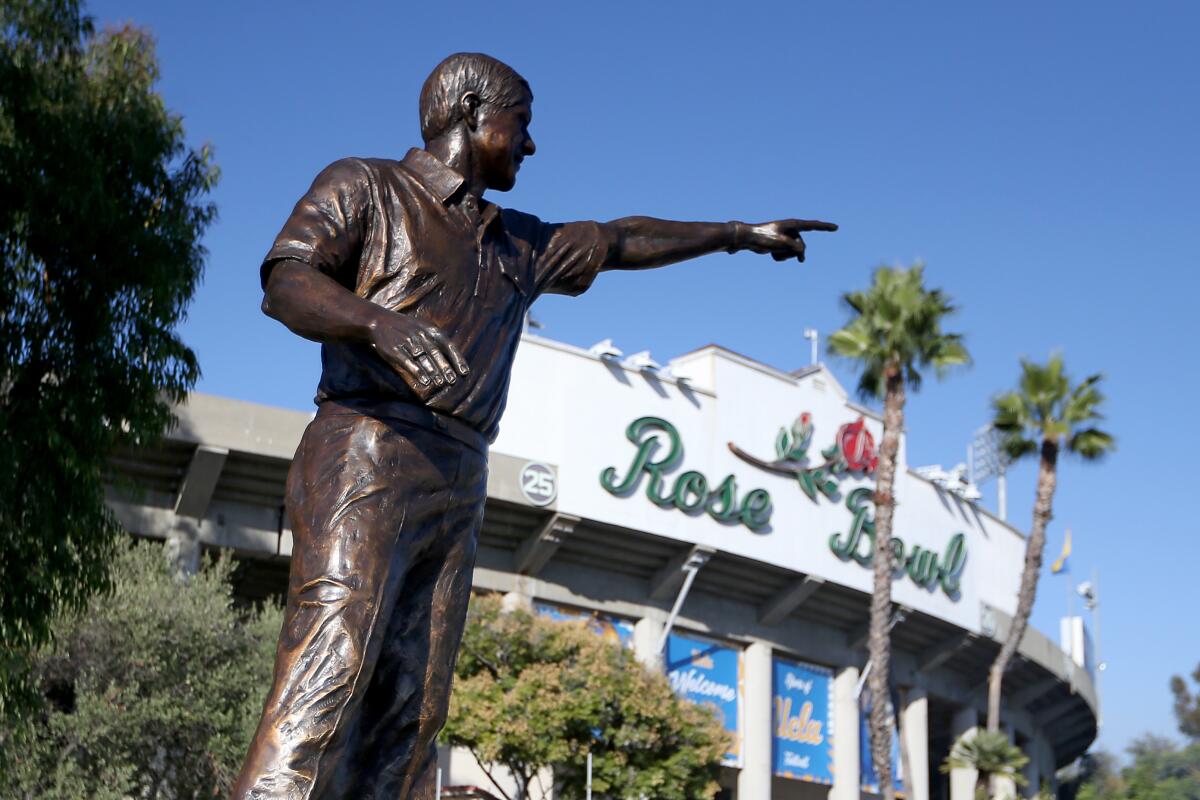
UCLA Bruins (Rose Bowl)
Year opened: 1922
Big Ten visitors in 2024: Indiana (Sept. 14), Oregon (Sept. 28), Minnesota (Oct. 12), Iowa (Nov. 8), USC (Nov. 23)
Nearby attractions: Norton Simon Museum, Old Pasadena, Bunny Museum
Before attending a Bruins game, you should probably familiarize yourself with the school’s famous “Eight-clap.” It may sound simple, but don’t be fooled.
First of all, the eight-clap actually involves a total of 20 claps. There’s also a secret signal to start things off, a certain way to yell “UCLA” (with extra emphasis on the “L”), the word “fight” thrown in there a few times and some counting involved as well. Good thing this 3-minute instruction video exists.
Part of the cheer also is shouted as the marching band finishes playing “Mighty Bruins” (fun fact: the fight song was composed by Bill Conti, who also wrote “Gonna Fly Now,” a.k.a. the theme to “Rocky,” and a ton of other movie songs).
The Bruins started playing their home games at the Rose Bowl in 1982, following a failed attempt to have a stadium built on campus in Westwood. On game days, students can make the 26-mile trek to Pasadena on the Rooter Bus.
One final tip to Big Ten fans attending a UCLA game for the first time: Don’t wear anything resembling Cardinal Red.
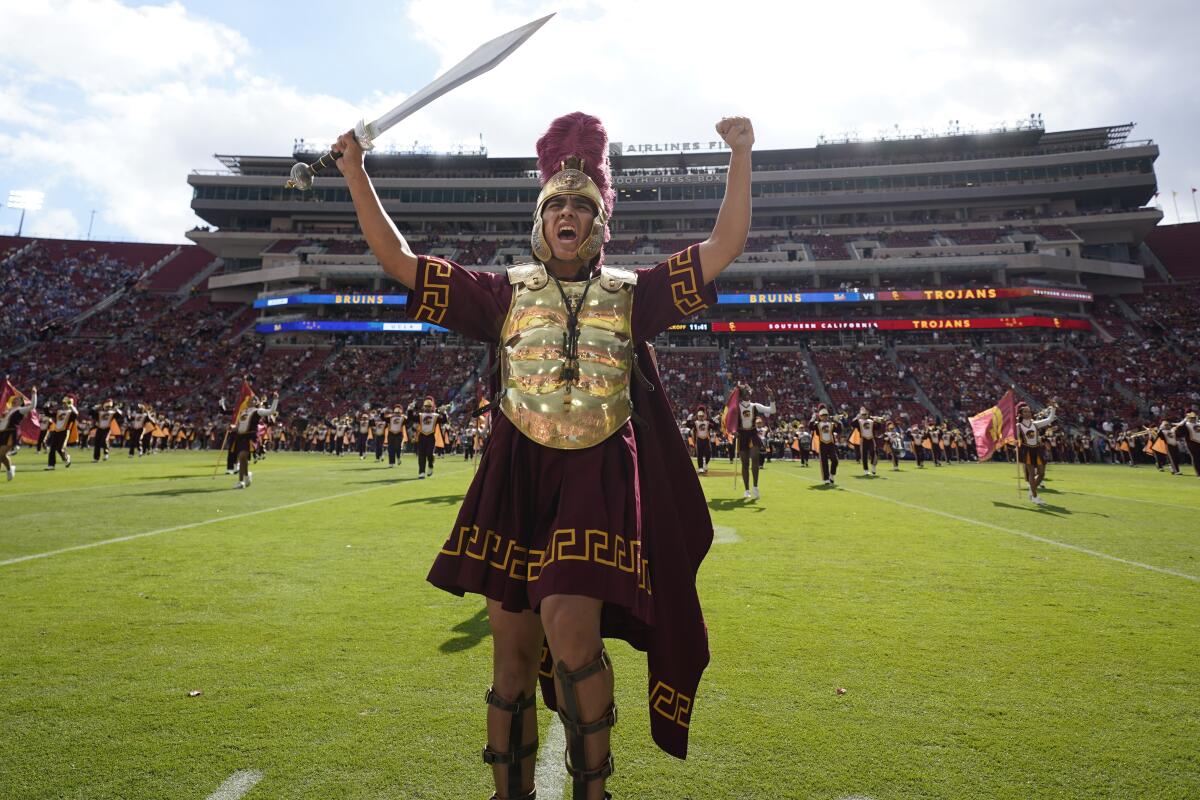
USC Trojans (L.A. Memorial Coliseum)
Year opened: 1923
Big Ten visitors in 2024: Wisconsin (Sept. 28), Penn State (Oct. 12), Rutgers (Oct. 25), Nebraska (Nov. 15)
Nearby attractions: Exposition Park, L.A. Live, Grand Central Market
When you encounter a Trojans fan, greet them by holding up two fingers in the victory sign and shout, “Fight on!” You’ll have a friend for life.
You also might witness your new friend kicking flagpoles on the way to the Coliseum. All USC fans do it for good luck.
In another tradition before every home game (and sometimes on the road), a drum major strides to the 50-yard-line and dramatically stabs the field with a sword. After a Trojans victory, a player uses the same sword to lead the band in song.
A horse named Traveler, is ridden around the Coliseum in celebration after every USC score. There have been several Travelers of various breeds since the tradition started in 1961, but the mascot’s web page says all of them have been “pure white.”
The Coliseum has been the home of numerous teams (UCLA football, the Rams, Chargers, Raiders, Dodgers) over the last century, but the Trojans literally have been there since Day 1 (Oct. 6, 1923, when USC beat Pomona College 23-7).
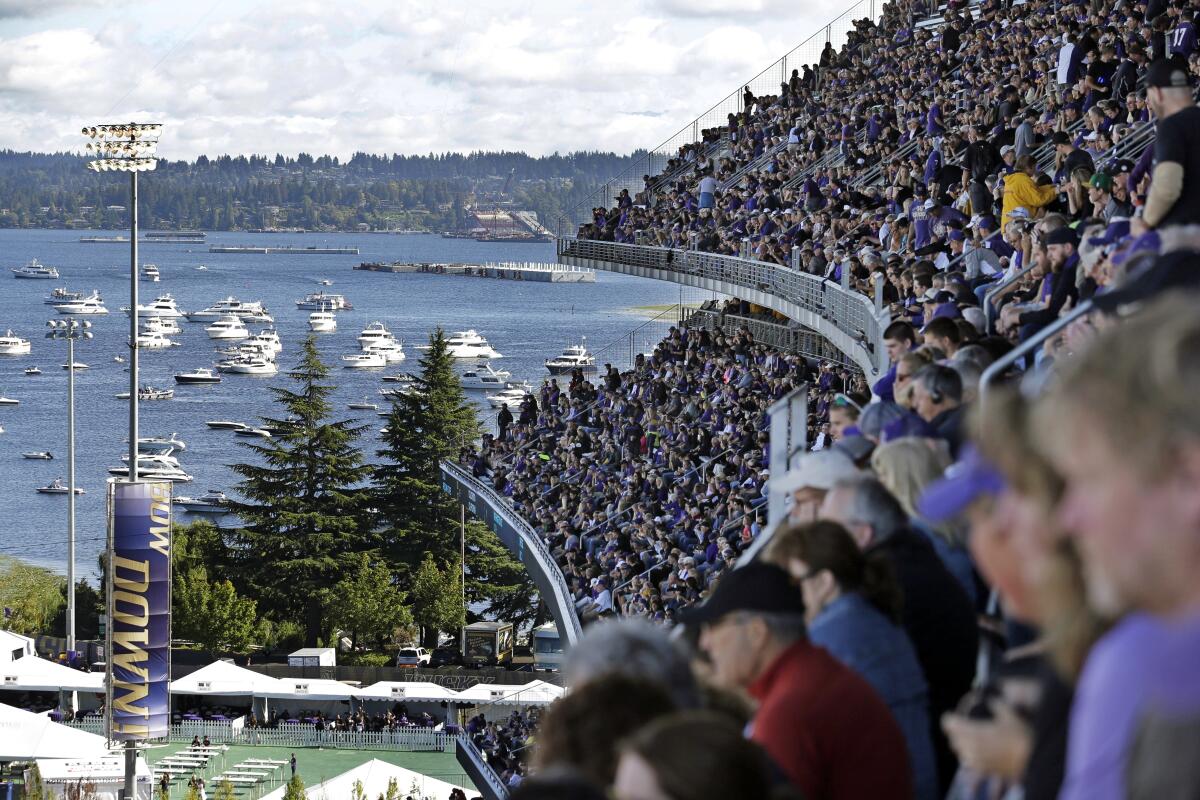
Washington Huskies (Husky Stadium)
Year opened: 1920
Distance from L.A.: 1,136 miles
When will UCLA play there? Nov. 15
When will USC play there? Nov. 2
Nearby attractions: The U District, Gas Works Park
The signature cheer of “Go Huskies!” (or sometimes simply “Go!”) might not be the most creative, but when shouted at a decibel level well into the triple digits while opposing teams attempt to get a play off, the chant more than serves its purpose.
A Sept. 19, 1992, game between No. 12 Nebraska and the No. 2 Huskies had crowd noise that reached 133.6 decibels, a college football record that stood until last year (137 decibels, Georgia at Tennessee on Nov. 18).
The stadium overlooks Lake Washington, so naturally “sailgating” is a thing on game days.
The stadium’s website also states that “the Wave” was “founded” there. While it may not have actually originated in Seattle, Washington fans started doing their own version of the group cheer during the 1981 season and helped turn it into a worldwide phenomenon.
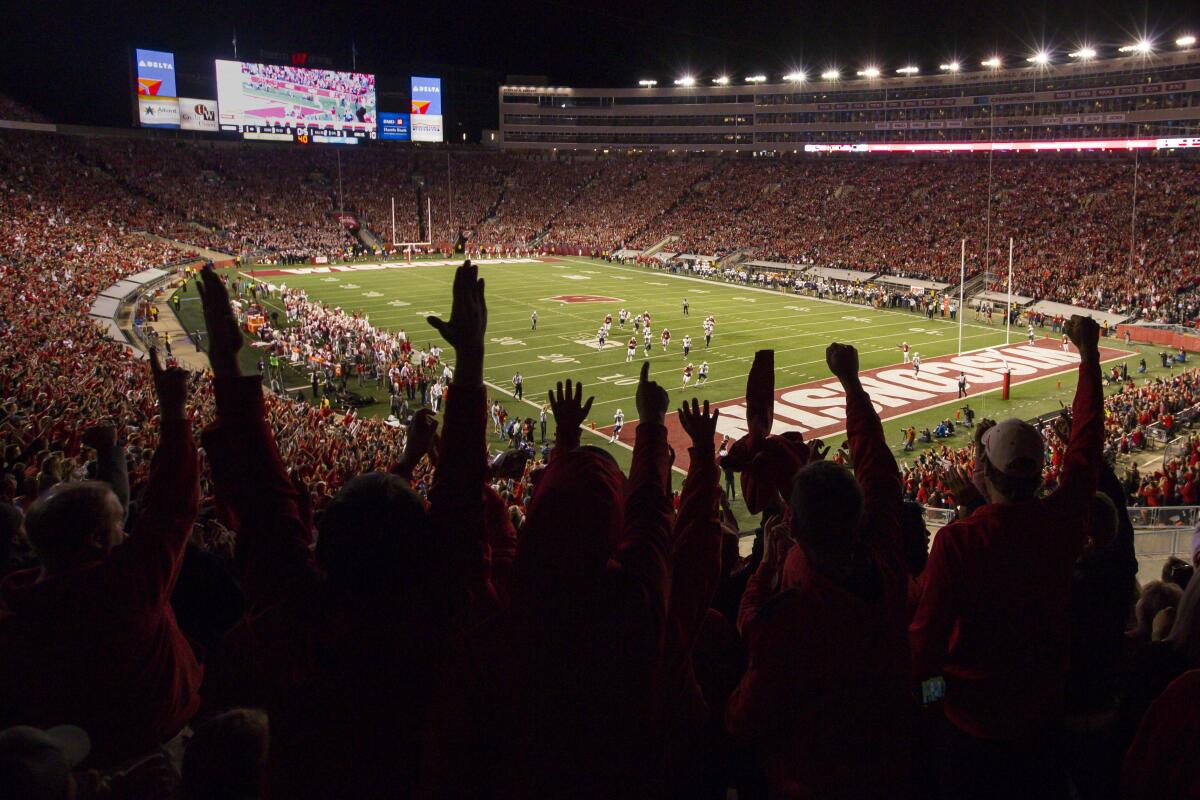
Wisconsin Badgers (Camp Randall Stadium)
Year opened: 1917
Distance from L.A.: 1,975 miles
When will UCLA play there? 2027
When will USC play there? 2026
Nearby attractions: Monroe Street, Olbrich Botanical Gardens
You’ve heard “Jump Around” by House of Pain before, likely at too many sporting events to count. But you haven’t really experienced the upbeat 1992 hit until you’ve done so at Camp Randall between the third and fourth quarters of home games.
There’s nothing fancy about what happens at that time, just every single Badgers fan in attendance obeying the song’s title in unison — so much so that school administrators unsuccessfully attempted to do away with the ritual in 2003 out of concern for the newly renovated stadium (which, of course, remains standing today).
Badgers fans also sing along to “Build Me Up Buttercup” by the Foundations during every game and sway arm-in-arm to the traditional “Varsity,” one of several tunes served up by the marching band during the school’s famous “Fifth Quarter.”
Camp Randall was originally a training site for the Union Army during the Civil War. The Badgers have played football at that location since 1895.
Go beyond the scoreboard
Get the latest on L.A.'s teams in the daily Sports Report newsletter.
You may occasionally receive promotional content from the Los Angeles Times.
